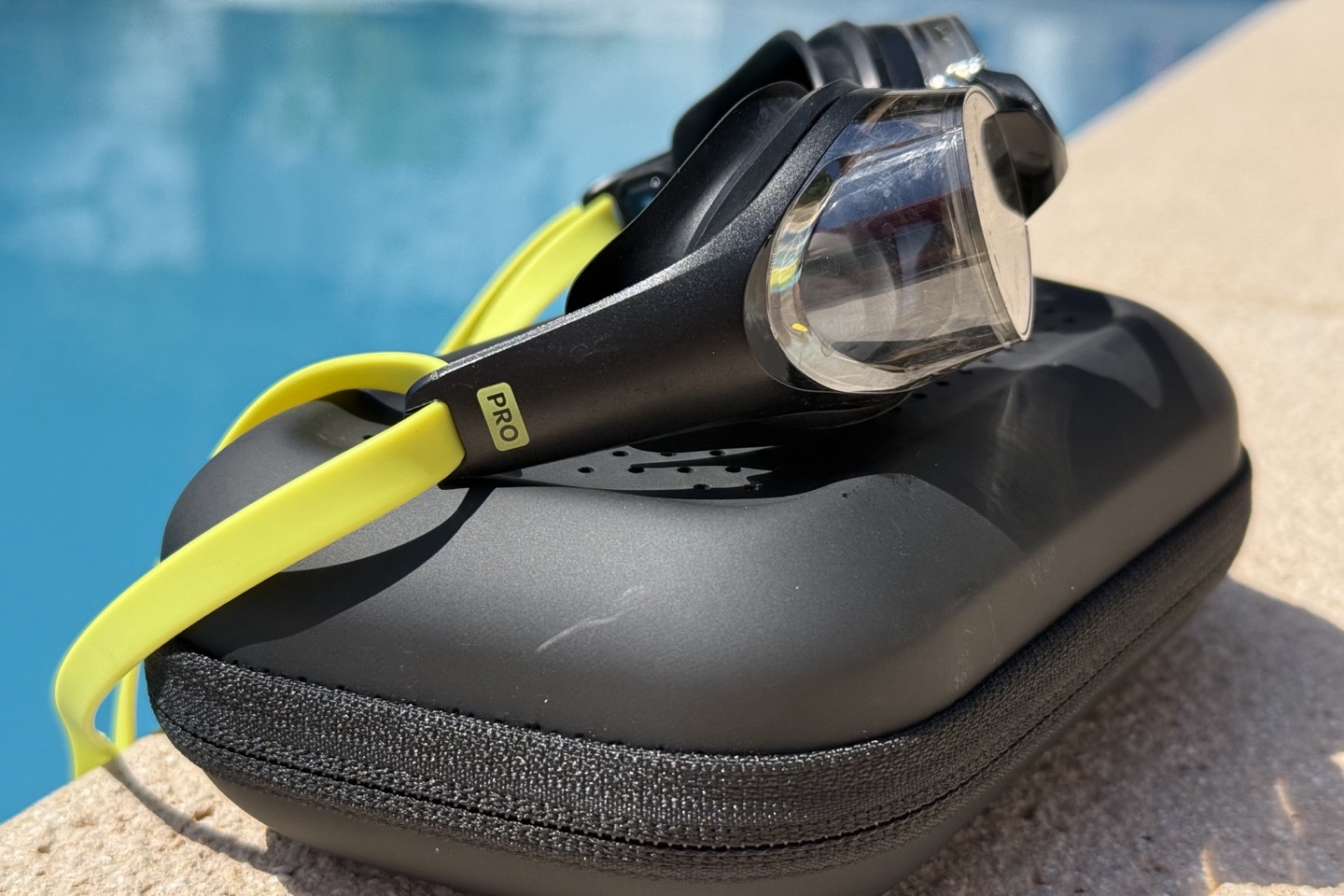
FORM has just announced their latest edition of their smart swimming goggle, the FORM Smart Swim 2 Pro. This unit brings with it one notable hardware change, along with a bunch of software changes (fear not, existing owners/subscribers get those software updates too).
Since the first edition of FORM, people have been concerned about scratching of the plastic lens on the FORM swim goggles. Well, the new Pro edition aims to solve that with Corning Gorilla Glass 3. Meanwhile, on the software side there’s new coaching enhancements, plus a more practical automatic interval counting feature that figures out your free swims in realtime, counting reps for your fully hands-free.
I’ve been giving the new FORM Smart Swim 2 Pro a whirl, along with my wife, to see what we like and don’t like. We’ve both got a fair bit of history with using the FORM Smart Swim products over the years, so I’m focusing most of this review on the new hardware and software changes. Though, if you’re new to what these sorts of goggles do, fear not, I cover the basics a bit as well.
With that, let’s get into it.
What’s New:
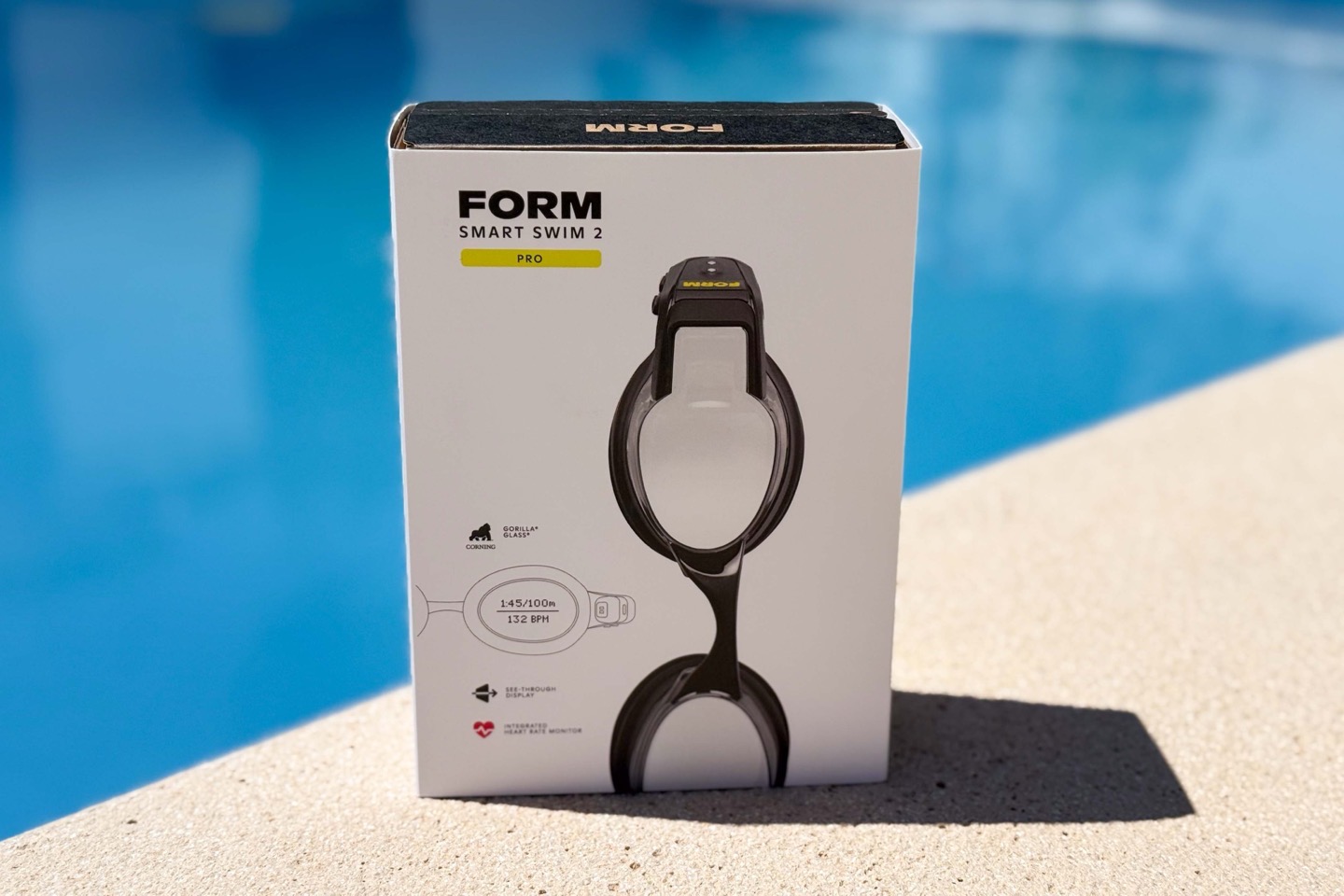
In many ways, this is a relatively simple product change, grouped into a hardware bucket of tweaks to the Swim 2 Pro, and then a software bucket of things that have started rolling out to all FORM swim goggles with a subscription.
First up, the hardware side:
– Switched to Corning Gorilla Glass 3: This is compared to the previous plastic material
– And…that’s it.
The battery life (14 hours), the tech inside, and everything else remains the same.
Next, the software changes going to all FORM swim goggles (albeit these new features require a subscription):
– Adding Smart Set: This will automatically figure out your free swim workouts on the fly, and start counting intervals/sets, without any input required. I used this yesterday, and it’s pretty cool. More on it down below.
– Adding HeadCoach Plans: The company says these will ‘continuously adapt’ the existing personalized swim plan, but based on ‘swim goals, swim history, and performance data’
– Adding HeadCoach Insights: Coming in September, this will give more insights, specifically around technique, both afterwards in the app, but also in Real-Time in the goggles.
In their presentation to media, FORM did outline all the software changes since April 2024 (when the Smart Swim 2 came out), which, I figured, is worthwhile mentioning here as well, in case that was the last time you thought/looked at FORM.
– Added Script Workout Builder: Let’s you take existing printed, typed, pasted, or even whiteboard photographs, and builds a guided workout for the app/goggles.
– Added Personalized HeadCoach Workouts: This will build works based on your history & goals, including HeadCoach components (HeadCoach is the piece that looks at your swim form, or more specifically, your head form).
– Added Goal Objectives: This can be upcoming races, Fitness, Technique, etc…which are then taken into account for automatically generated workouts
– Added Ability to Turn Existing Free Swim Into Guided Workout: If you free swam a workout, you can then turn it into a guided workout for future swims.
– Added Openwater SwimStraight Auto Calibration, Realtime Pace with Watch: Plus some other stability improvements
FORM says that the existing Smart Swim 2 will remain in the market as a cheaper option, at $279, versus the new Smart Swim 2 Pro, at $329USD. Here’s the pricing for other currencies:

As noted above, the Swim 2 Pro is available from today, July 15th, 2025.
Finally, as with before, the bulk of FORM’s focus is on their subscription, which is $119/year (if billed annually) or $15/month (if billed monthly). One month free is included for new customers.
Certainly, plenty of people have subscription fatigue. And the goggles do work without it at a basic swim tracking level, though some key features like structure workouts (including your own TrainingPeaks workouts) isn’t permitted without it. Here’s the feature differences:
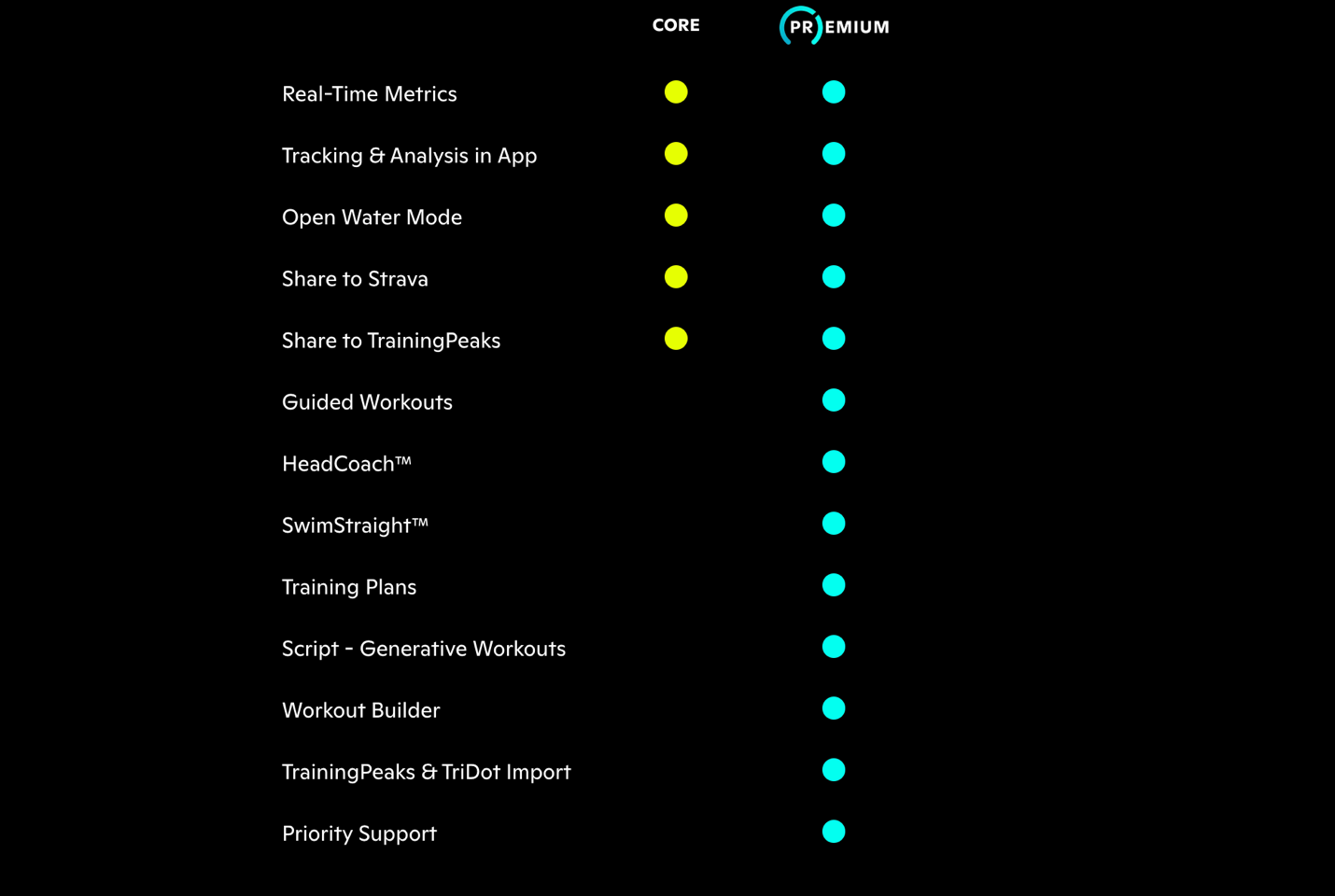
And as much as I hate more subscriptions, I’ll give FORM credit that they have legit tried every possible business model over their history (non-subscription, blended subscription, back to non-subscription, free initial subscription, etc…), and ultimately, the only one that works for them is this one. When a company has seemingly tried all the options, repeatedly, it’s hard to fault them for choosing what works for them as a business.
In the Box:
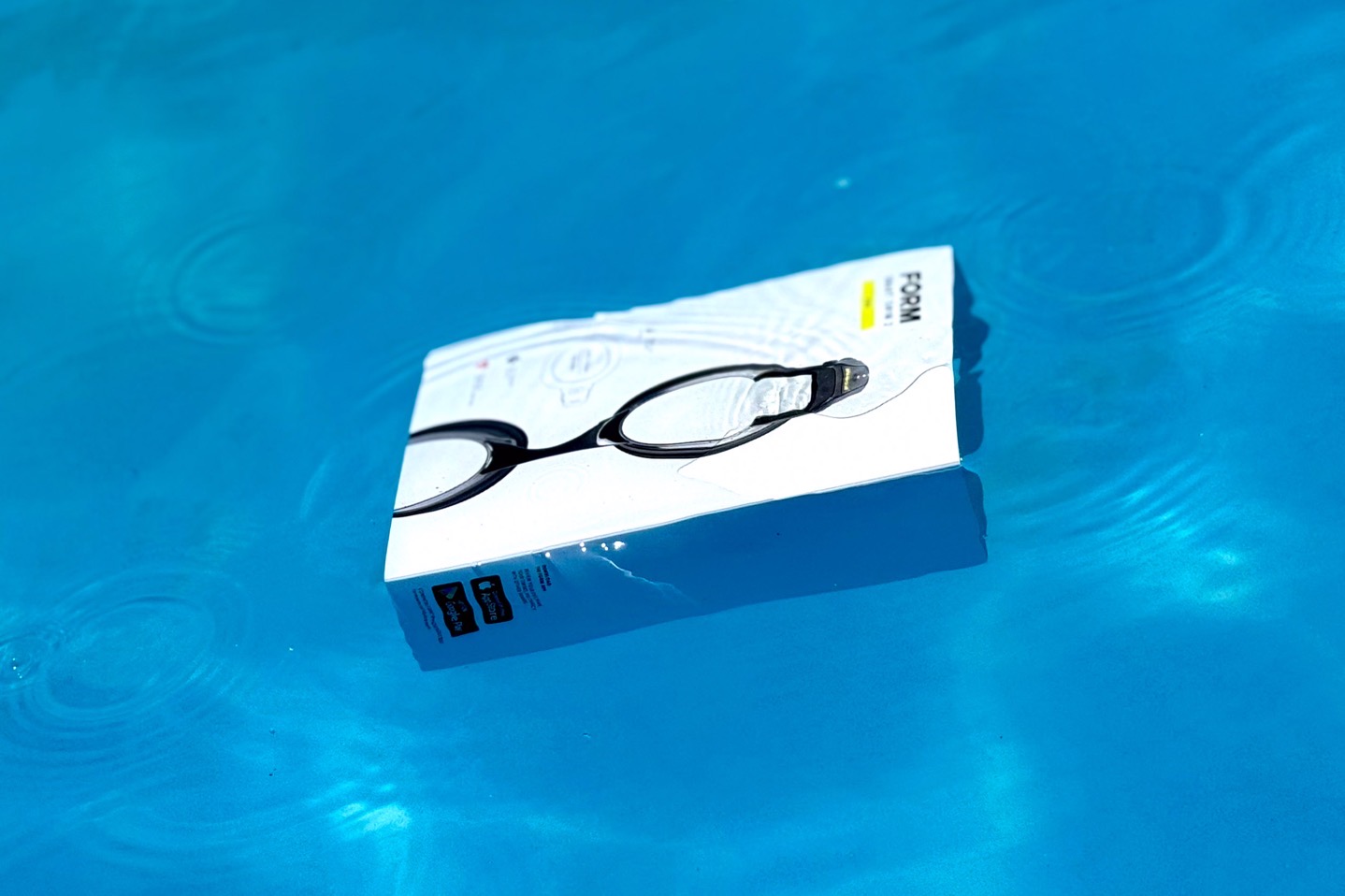
(As I was taking these shots, the wind caught the box cover and flung it into the pool. Kinda came out artsy…)
Now, let’s take a quick look inside the box of the Pro:
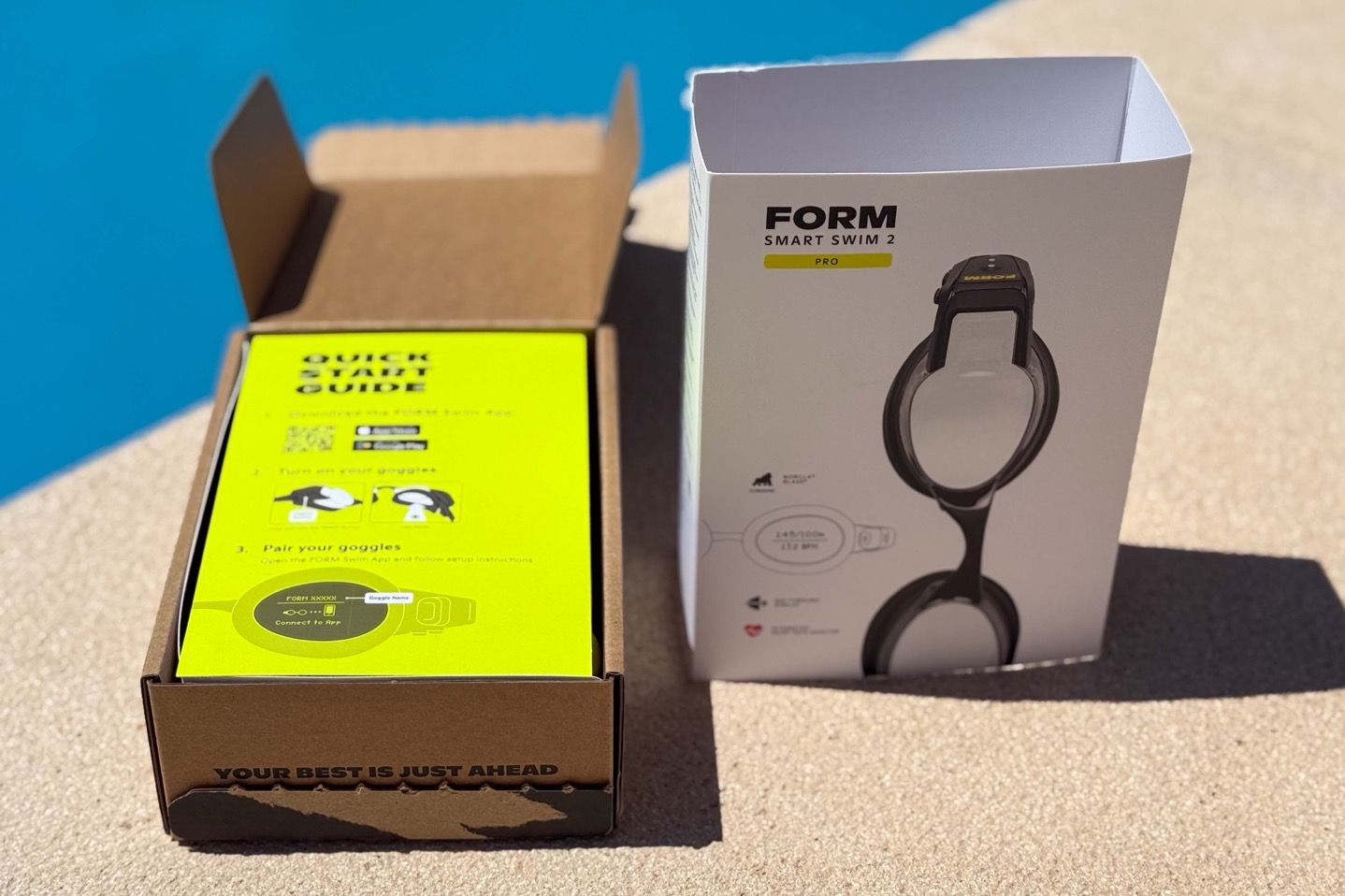
In many ways, it’s just like past units, except, one key difference: It includes anti-fogging spray. Well actually, it includes both anti-fogging spray (pre-mixed), and a secondary bottle of baby shampoo, so you can make your own additional spray by simply mixing it with water. More on that in a moment.
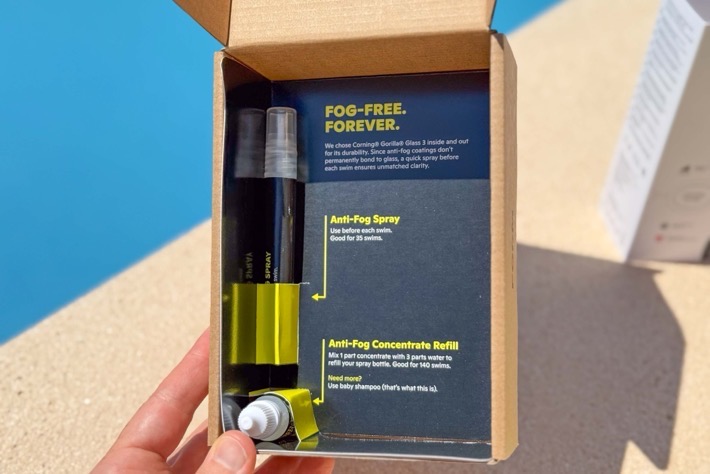
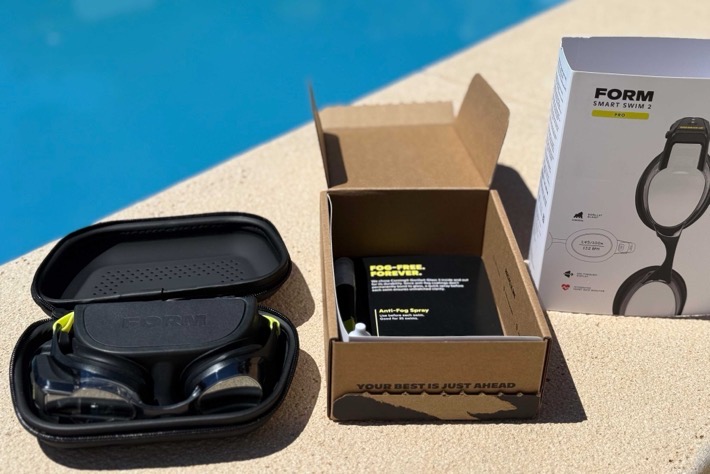
Here’s everything laid out nice and pretty…before the wind took hold of things:
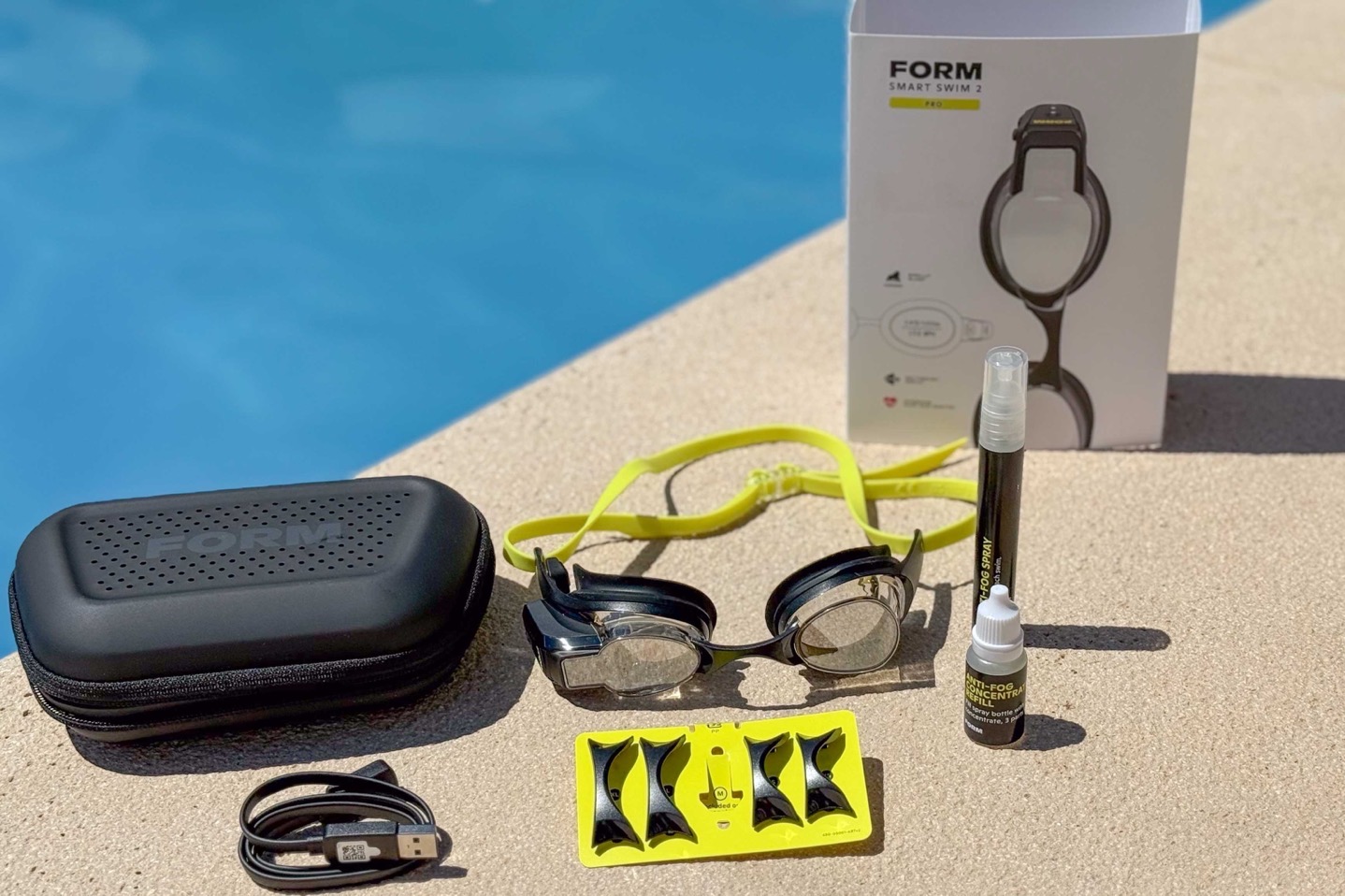
You’ll also notice the cable somehow still isn’t USB-C. In talking to FORM, they say work is already underwater on a USB-C version of it. This specific device is exempted from the EU rules on USB-C (there are many exemptions). Sigh.
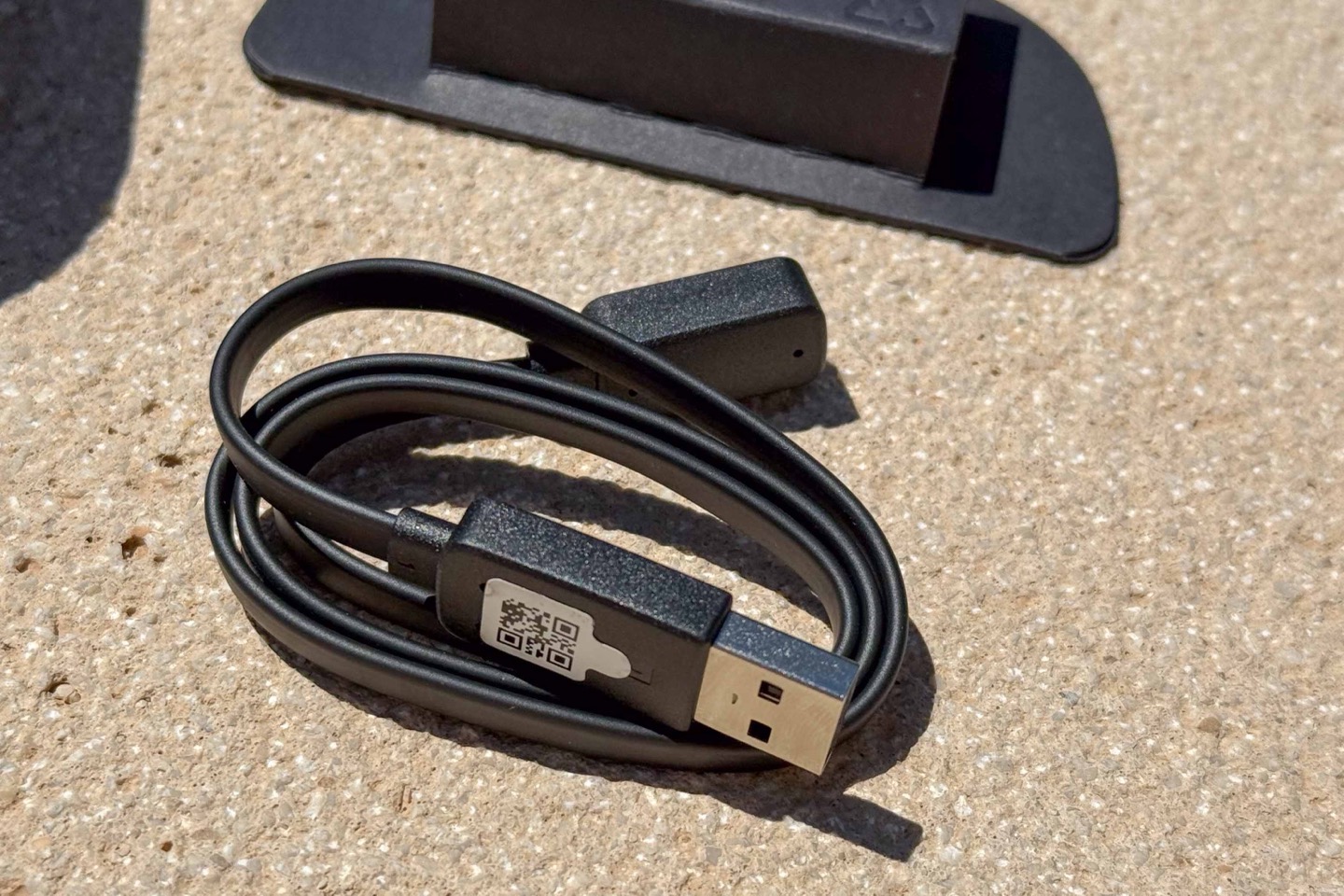
In any case, inside said case you’ve got the goggles, plus a bunch of different nose bridge sizes. As always with swim goggles, getting the fit correct is the most important defense against leakage and other bad things.
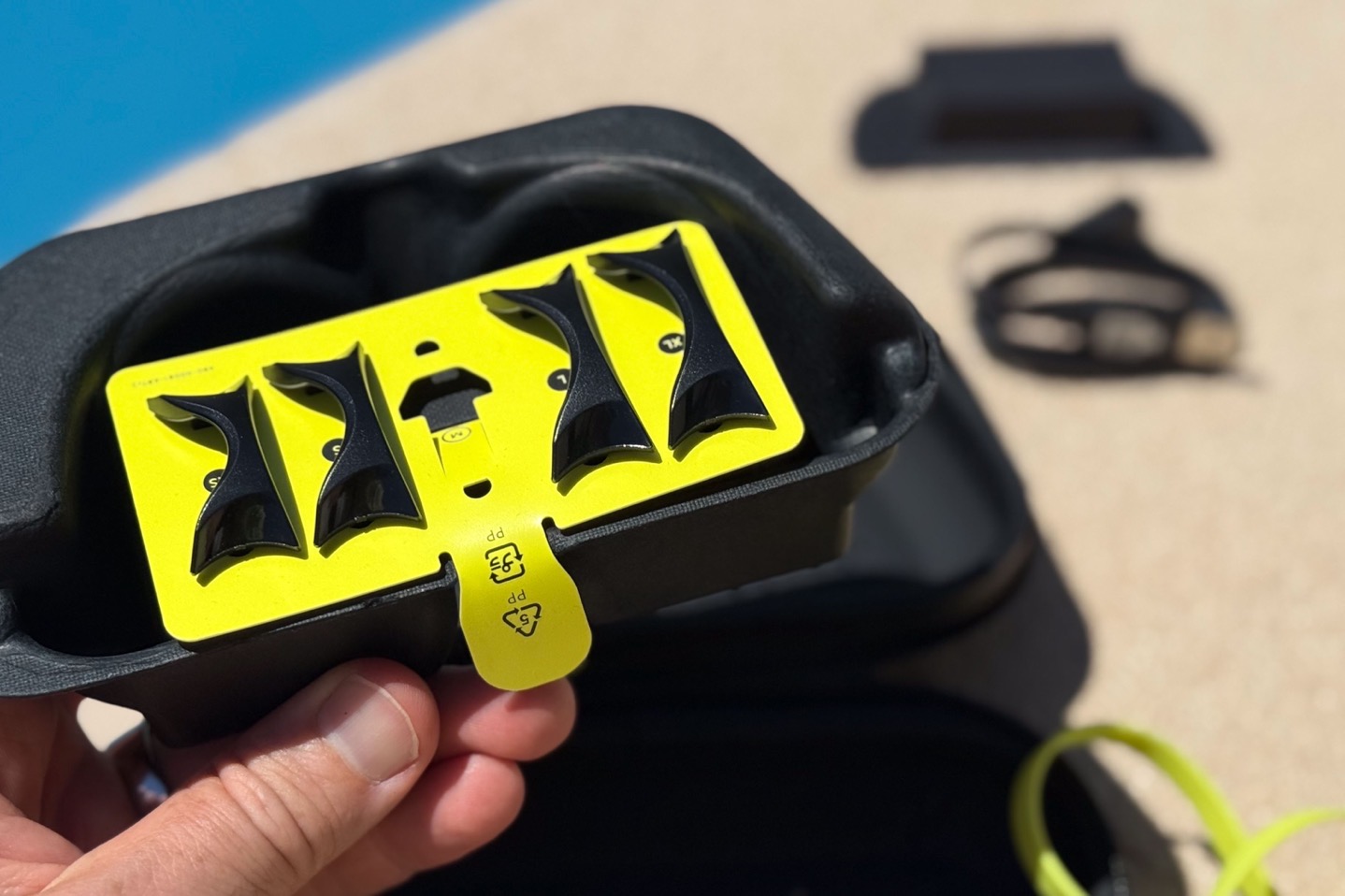
Like past cases, it’s got small drain holes on it, so it’ll both let water drain out of the case (and air in), while protecting the goggles.
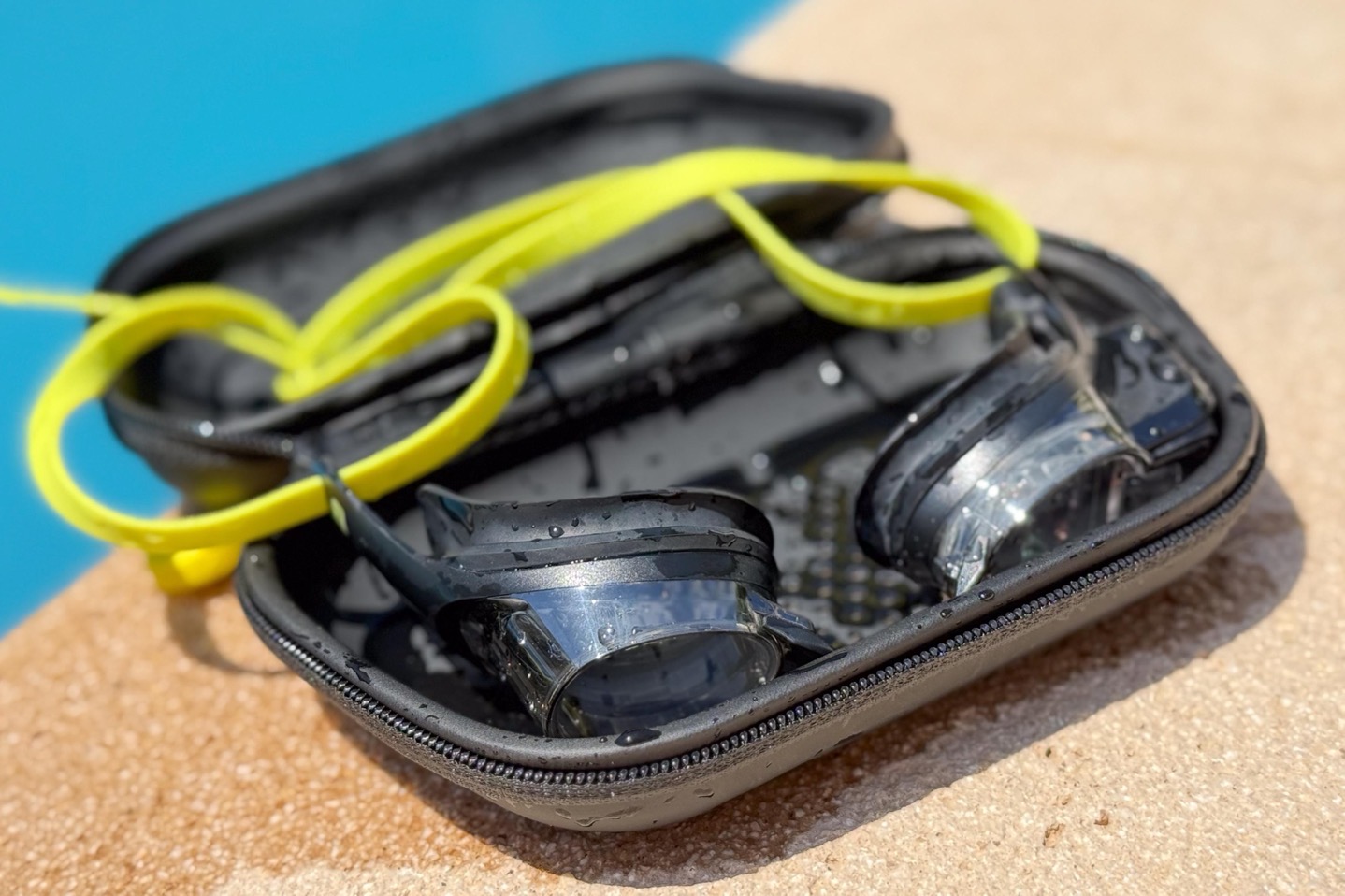
And also like the past, the Swim 2 Pro retains the optical HR sensor to measure your heart rate during your swims:
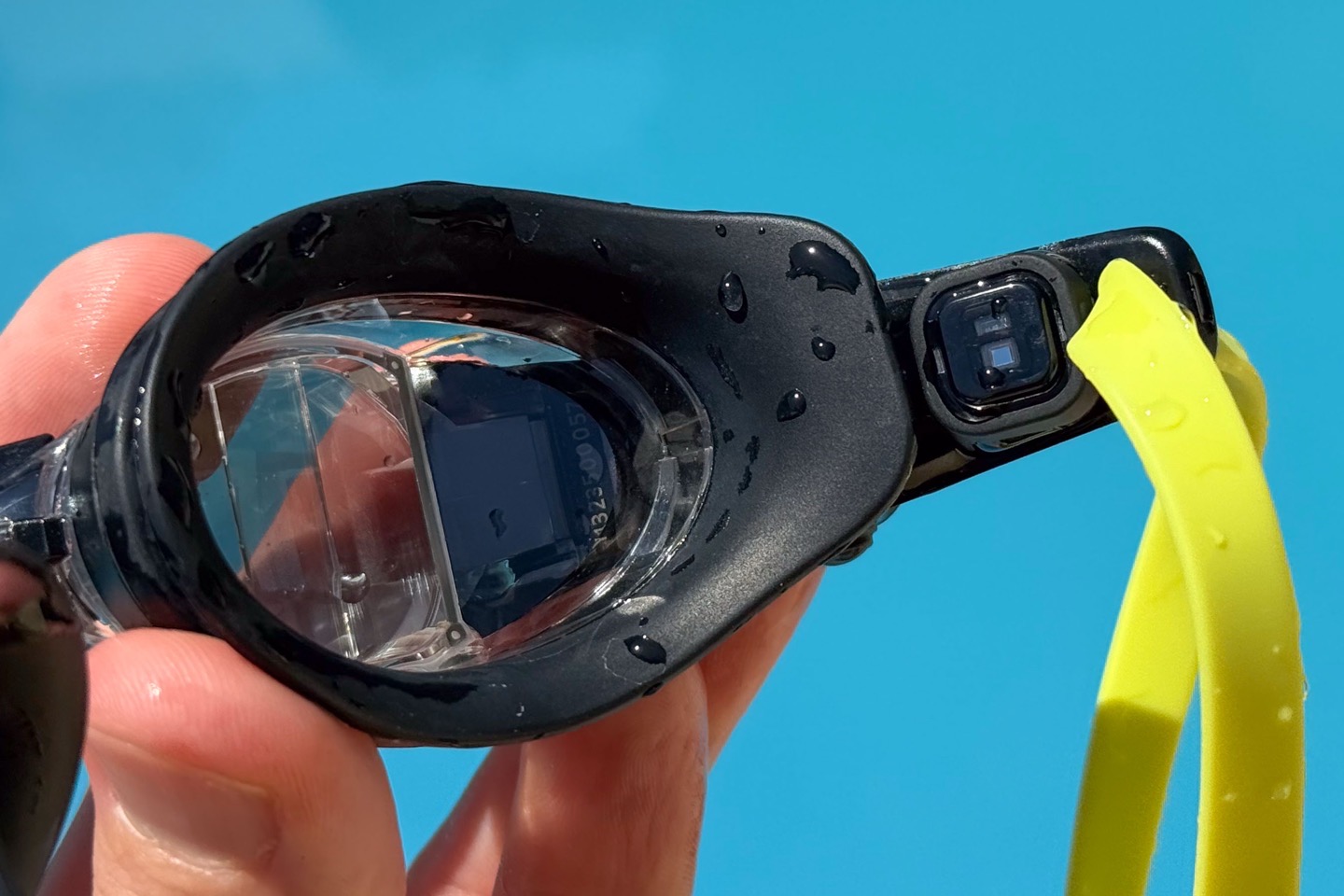
As with the past, I find it can be a tiny bit fiddly to get the positioning perfect, though, once you’ve got it, it’s good for the rest of that swim. In my accuracy testing then, I basically noted it was all or nothing. Either it was connected (signal lock) and perfectly accurate, or it lost signal entirely. There seemed to be virtually no middle-ground of signal but incorrect. Since this component hasn’t’ changed, I didn’t specifically re-test this piece, though, did keep an eye on it, and the results were the same again.
The FORM Swim 2 Pro:
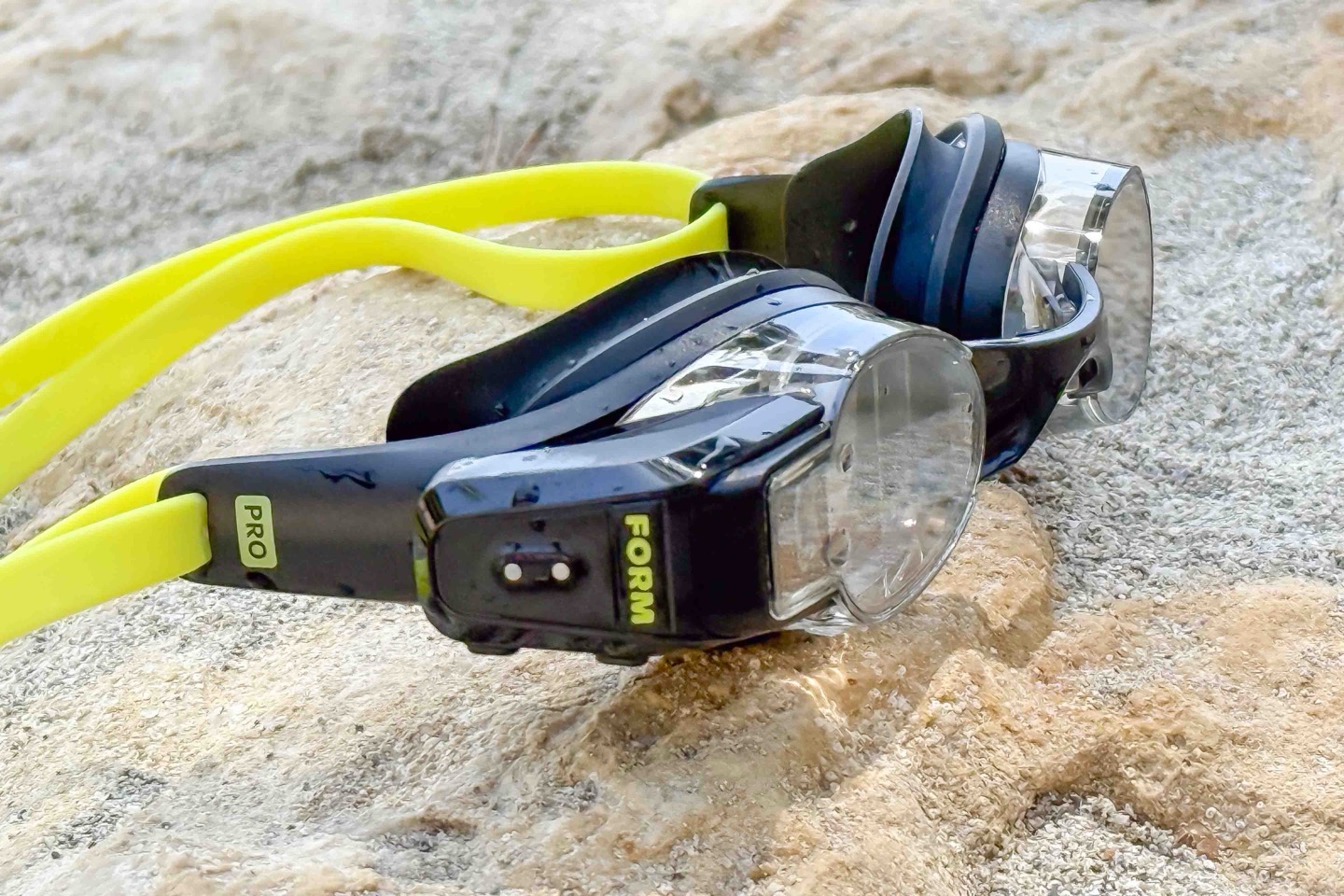
Now, the marquee feature of the Swim 2 Pro hardware is that they’ve switched from plastic to Corning Gorilla Glass (specifically, Gorilla Glass 3). The purpose of doing so is to increase scratch and crack resistance. If you look at the two side-by-side, they’re nearly identical, though you can see some very slight differences in where the glass extends to:
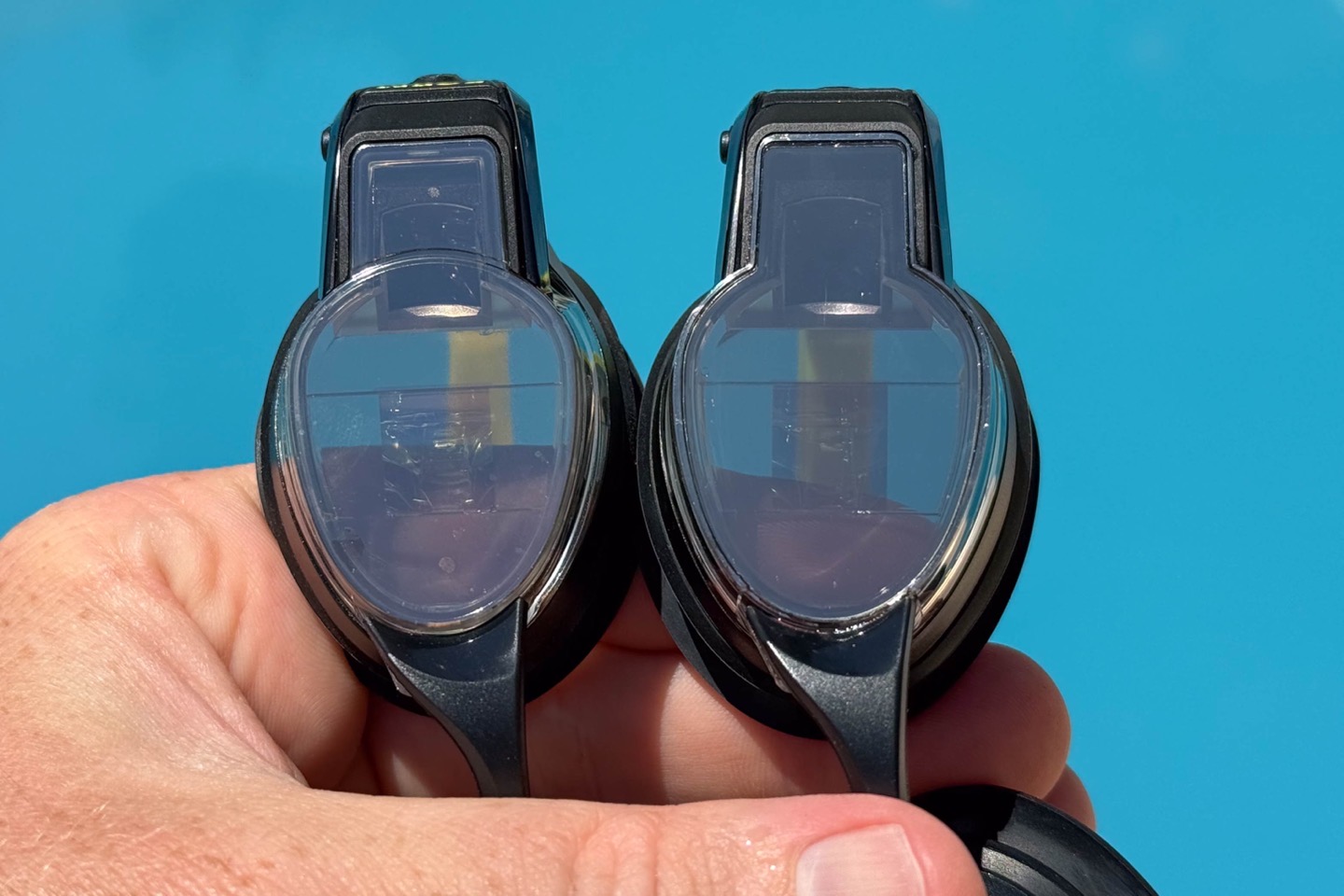
On all the above/below, the newer ‘Pro’ model is on the right.
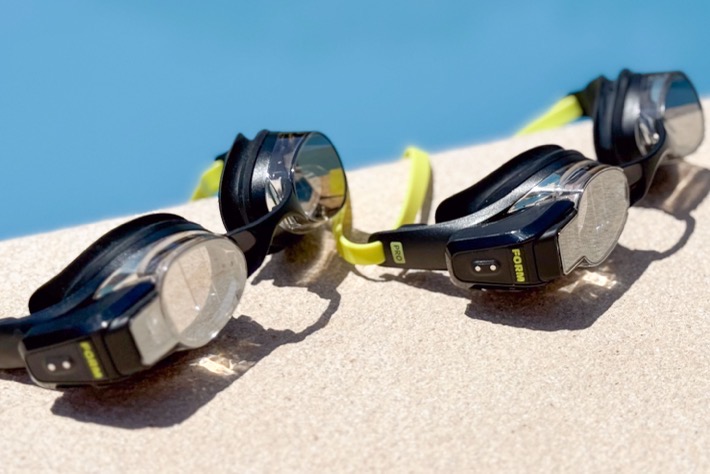
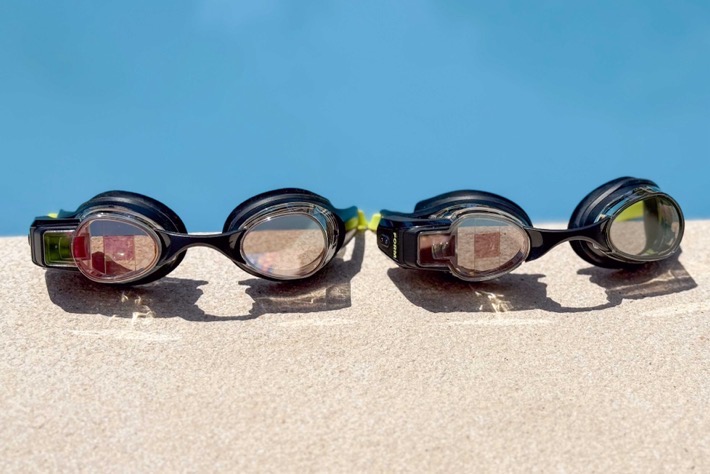
Also, in case you didn’t notice, iit says ‘Pro’ on the side of the Pro model now. Note though that switching to glass does add a tiny bit of weight, now claimed at 73.4g instead of 70g.
In asking them how they selected the specific model/type of glass from Corning (since the company has *many* varieties available), they largely let Corning decide the best glass for this application, in terms of their requirements around the specific thickness and impact resistance they needed. Hence the Gorilla Glass 3 selection.
Additionally, they noted that on the new Pro model, the glass has a near-invisible level of recessing that you can just barely see if you look close enough (and while hard to photograph, it’s true, it’s what’s probably a fraction of a millimeter lower than the edge of the glass, where it intersects the plastic sidewalls).
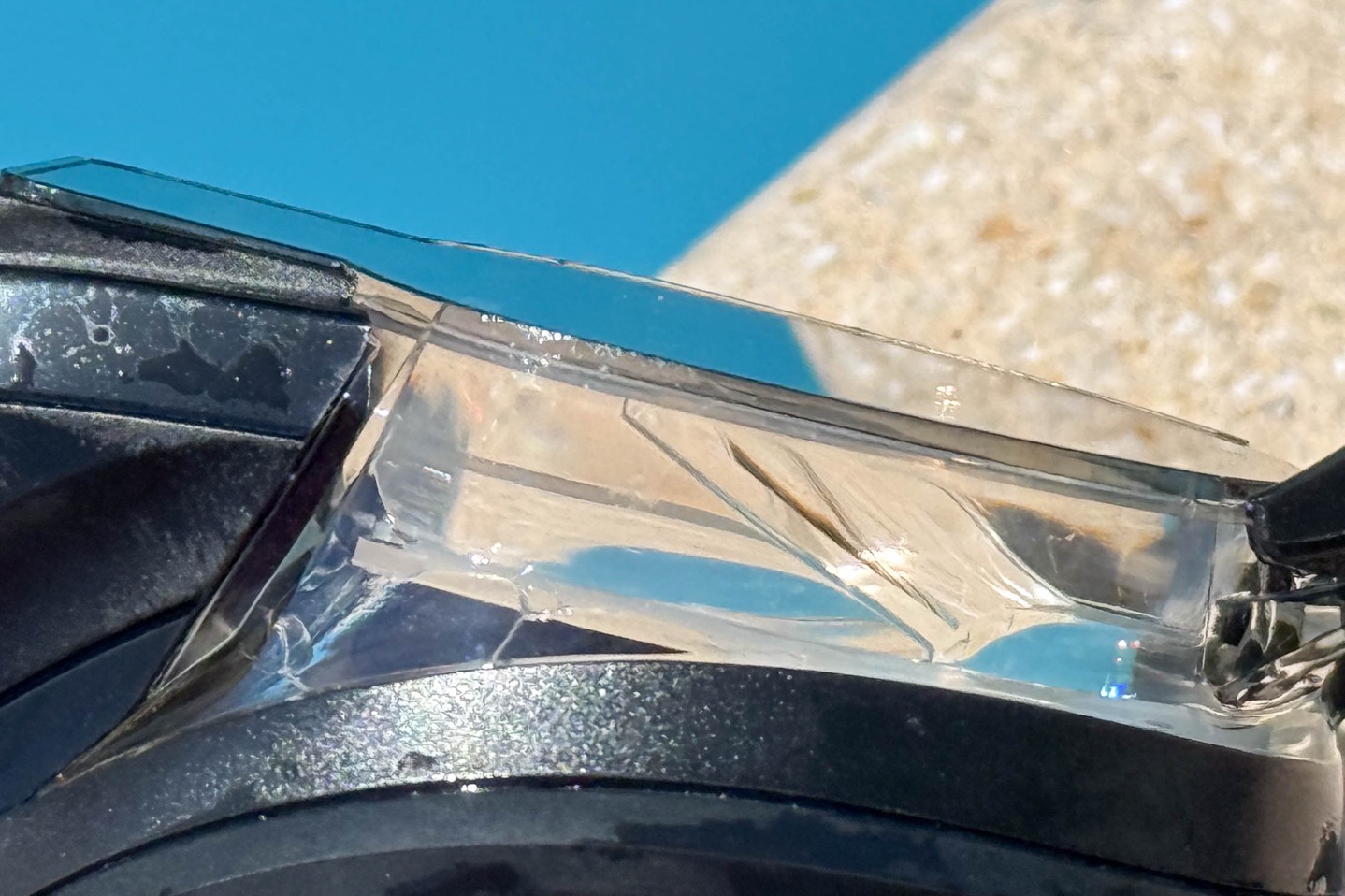
Ultimately, the company says all of this will protect the goggles from scratching on the pool deck, and any other wild places you take it…so, it’s time to meet my pool deck. The area around the pool has two surface types. The first is akin to a bathroom tile, but with a bit more grit to it. The kids don’t generally scrape their knees on this portion, it’s just not gritty enough. Still, I dragged the goggles lens-side-down the entire length of the pool, including moments where I applied downwards pressure. Then, I dropped it 4 times, glass-side down hitting the tile, starting at belly height, and then ultimately at head height.
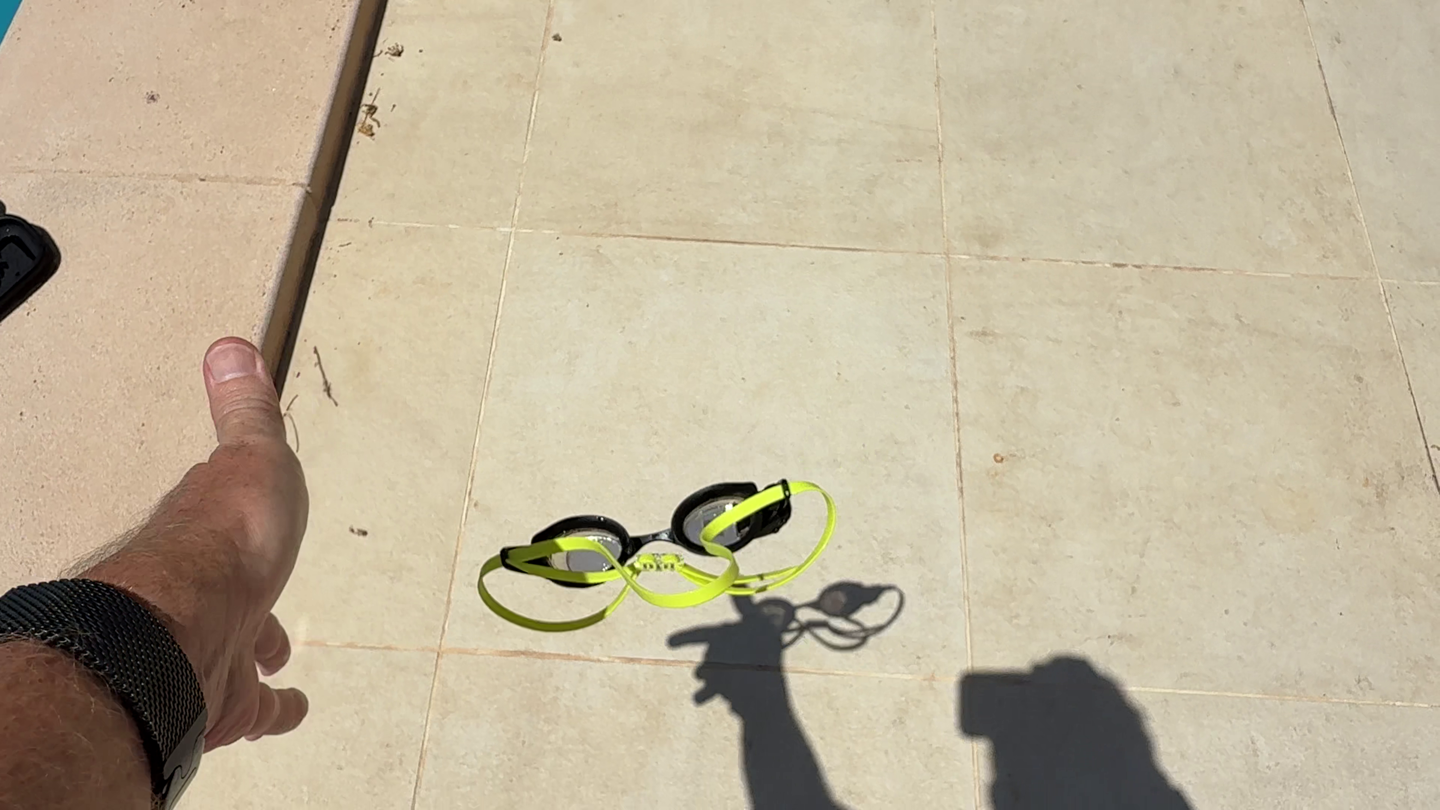
After this, I inspected it and found nothing. No changes.
So next, I brought it over to the @#$@# gritty pool edge. This concrete sucks, and is the bane of all of our existence, as it’s super gritty and will rip your skin apart like a cheese grater. Everyone in our family has marks from it. As a reminder, here’s close-up what that looks like first:
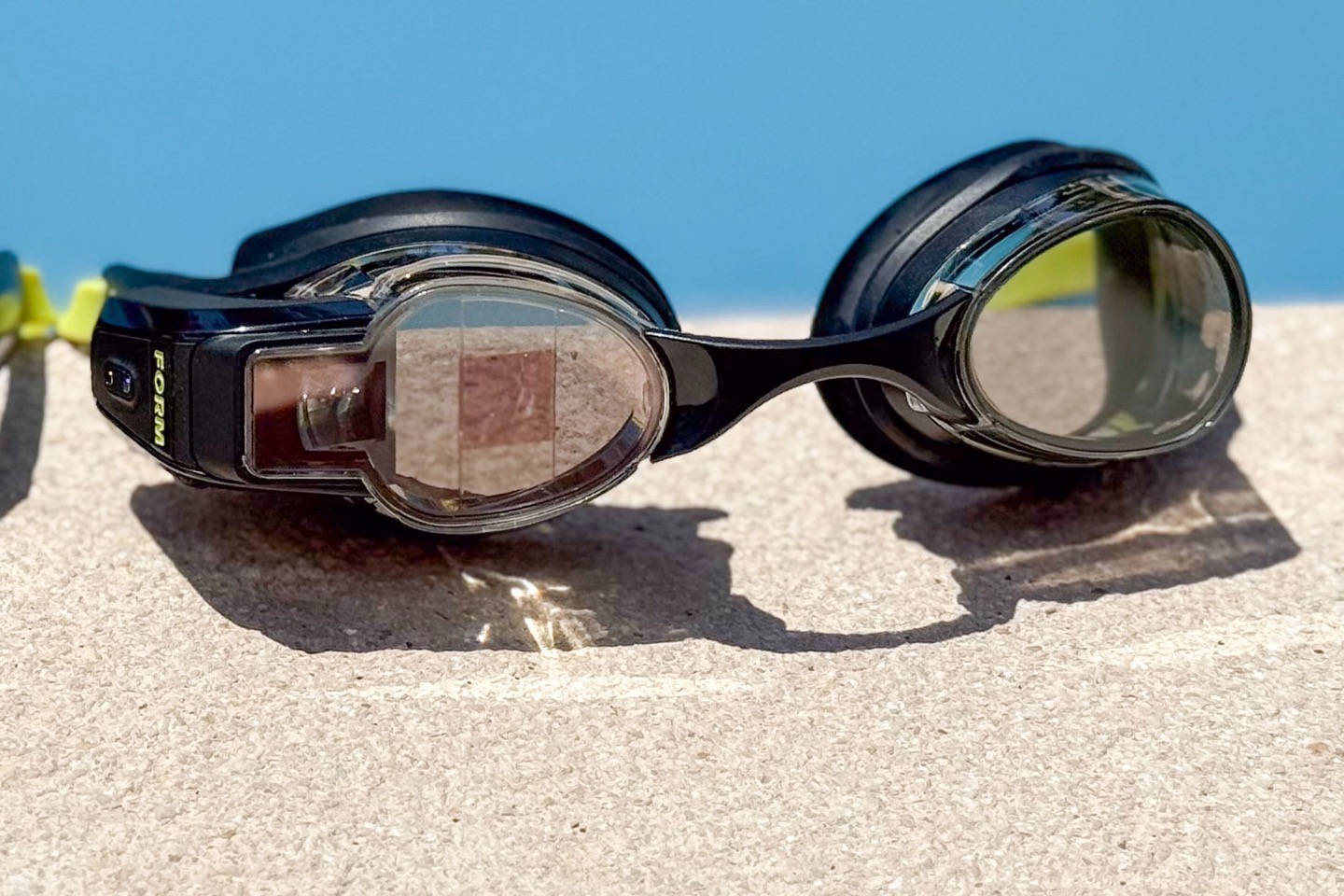
So then again, I dragged the goggles the entire length of the pool (I think it’s 8 meters)…and this time, things left a mark. But critically, NOT on the glass. They left a mark on the edge of the plastic (where the sidewall intersects), but not on the actual goggles themselves. You can see it looks a little bit chewed up:
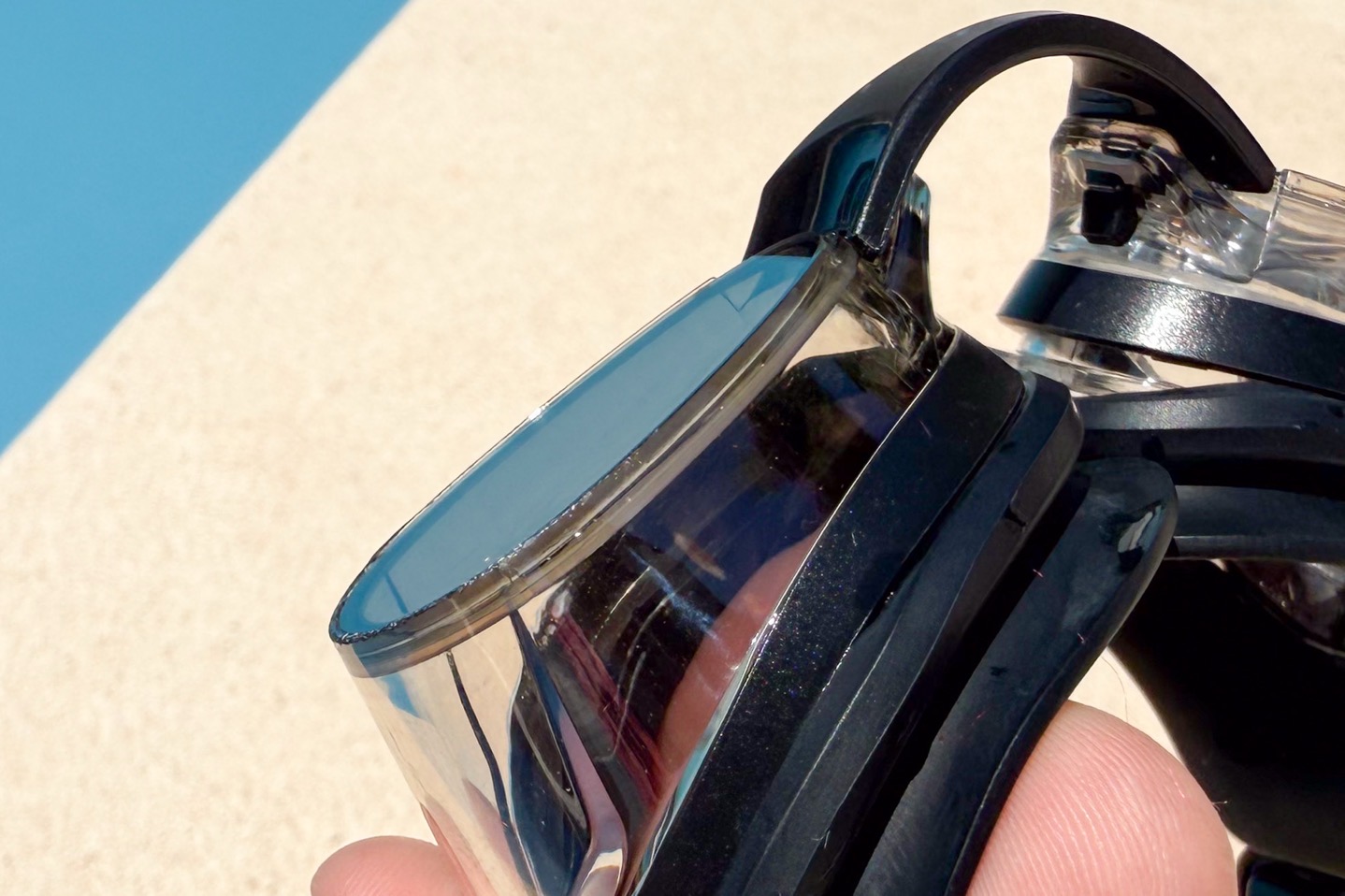
But the glass itself? Perfectly clear.
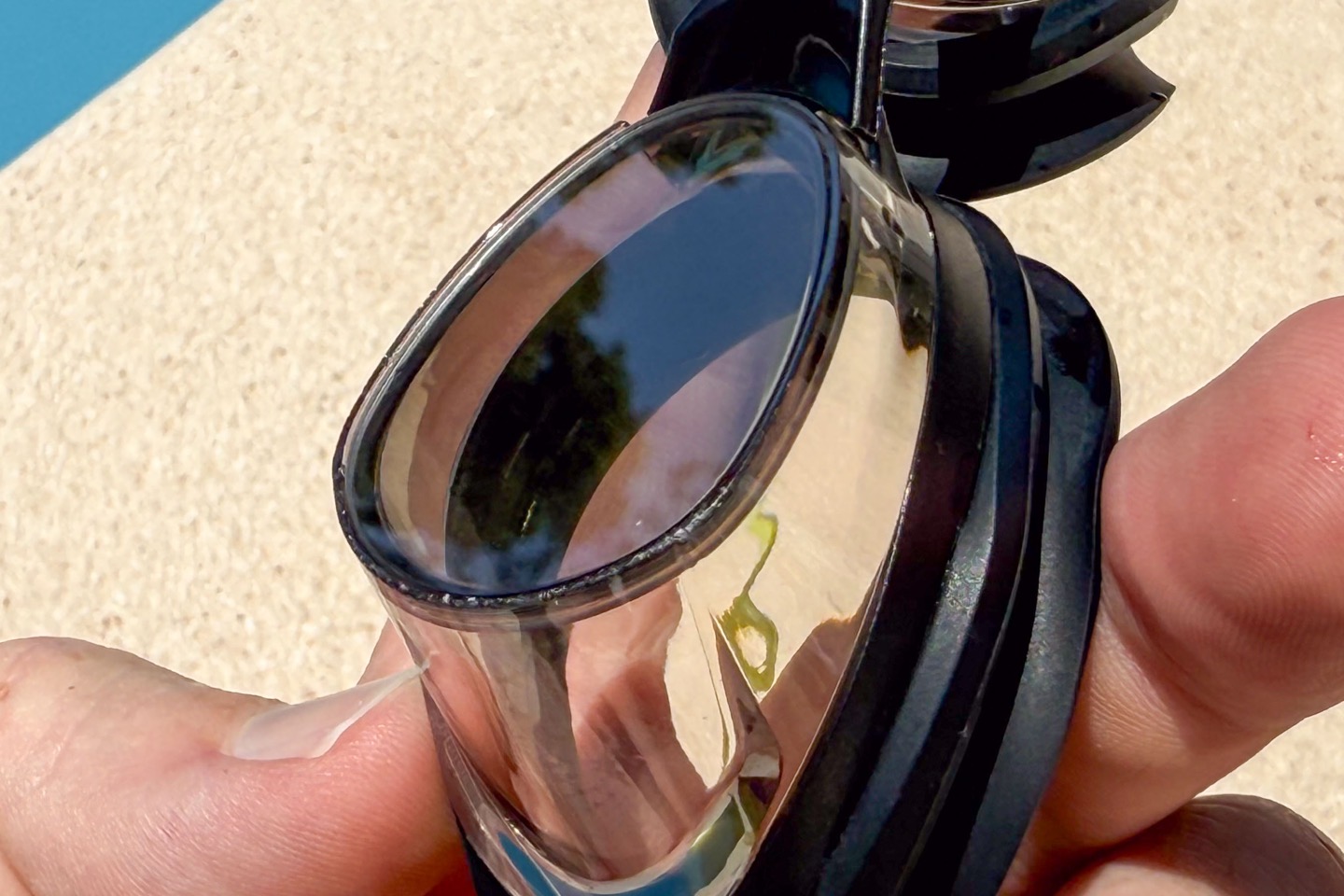
So kudos to FORM on this one. The core reason people cared about this, was to reduce scratching on the main lens – and they accomplished that. After dragging it on two different surfaces down the pool length, and repeated drops from any plausible scenario height, it’s flawless.
Now, the one downside to glass, its that it’s unable to hold an Anti-Fog coating like the base Smart Swim 2 can. That coating can’t be applied to glass (whereas it can be applied to plastic). In discussions with FORM, they tried numerous designs over the development period, but ultimately, the best overall anti-fog protection was simply a mixture of baby shampoo. Hence how you got yourself a spray bottle of anti-fogging liquid, along with an extra supply of baby shampoo.
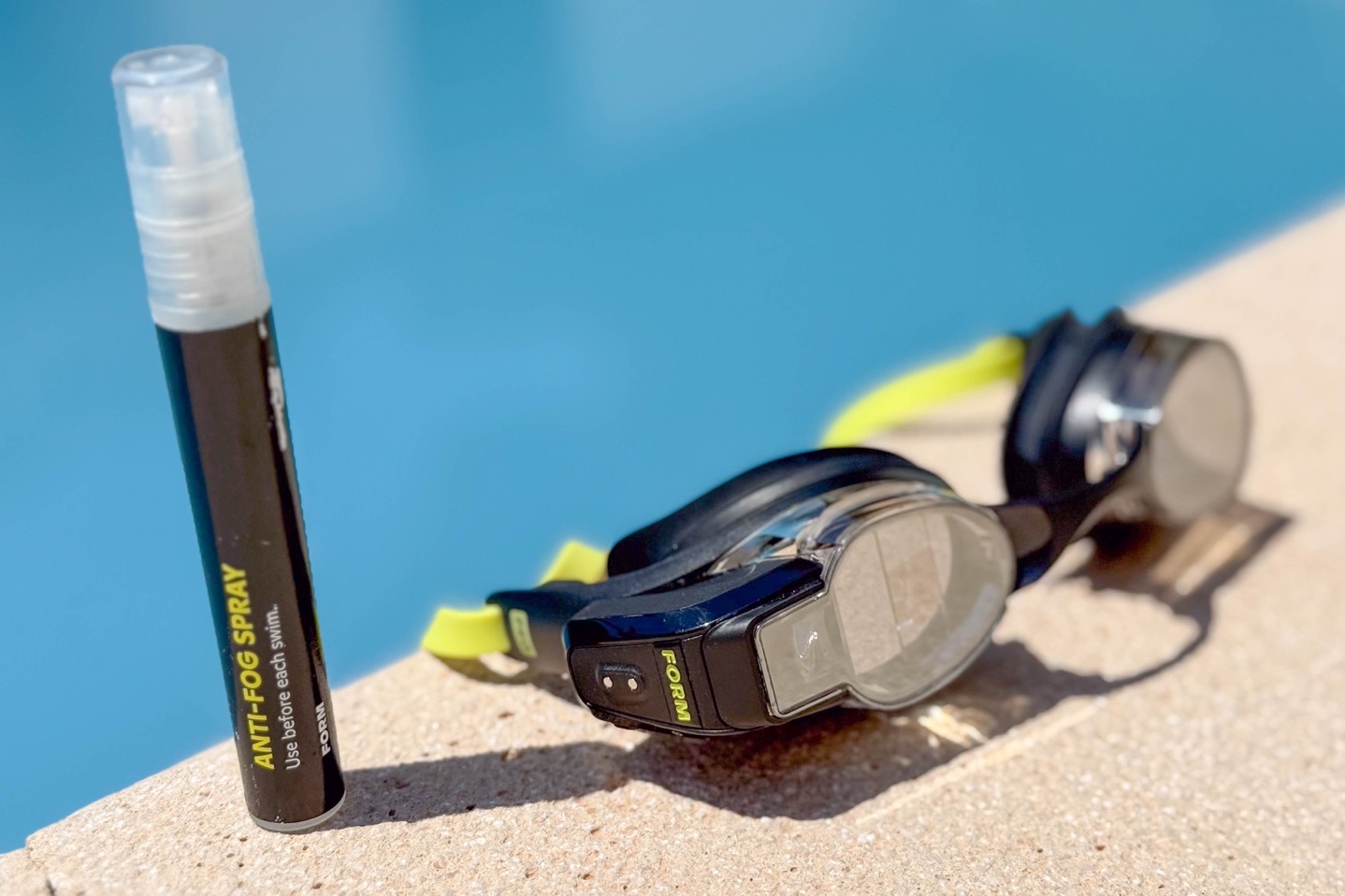
In my call with FORM, they were pretty adamant they don’t want to be in the anti-fogging liquid business. So much so that they wanted to be crystal clear this is nothing more than baby shampoo mixed at a 4:1 ratio (4 parts water, 1 part baby shampoo). That’s it. They don’t want to be making money on the spray, and a reason why they give you an extra supply of it, and are being super clear that “it’s just baby shampoo”.
In order to use it, you simply spray once per eye cup. In fact, when you power on the goggles for reach swim, it reminds you to do exactly that. The spray bottle will last 35 swims, and then the additional concentrate bottle will let you make another 140 swims of anti-fogging solution.
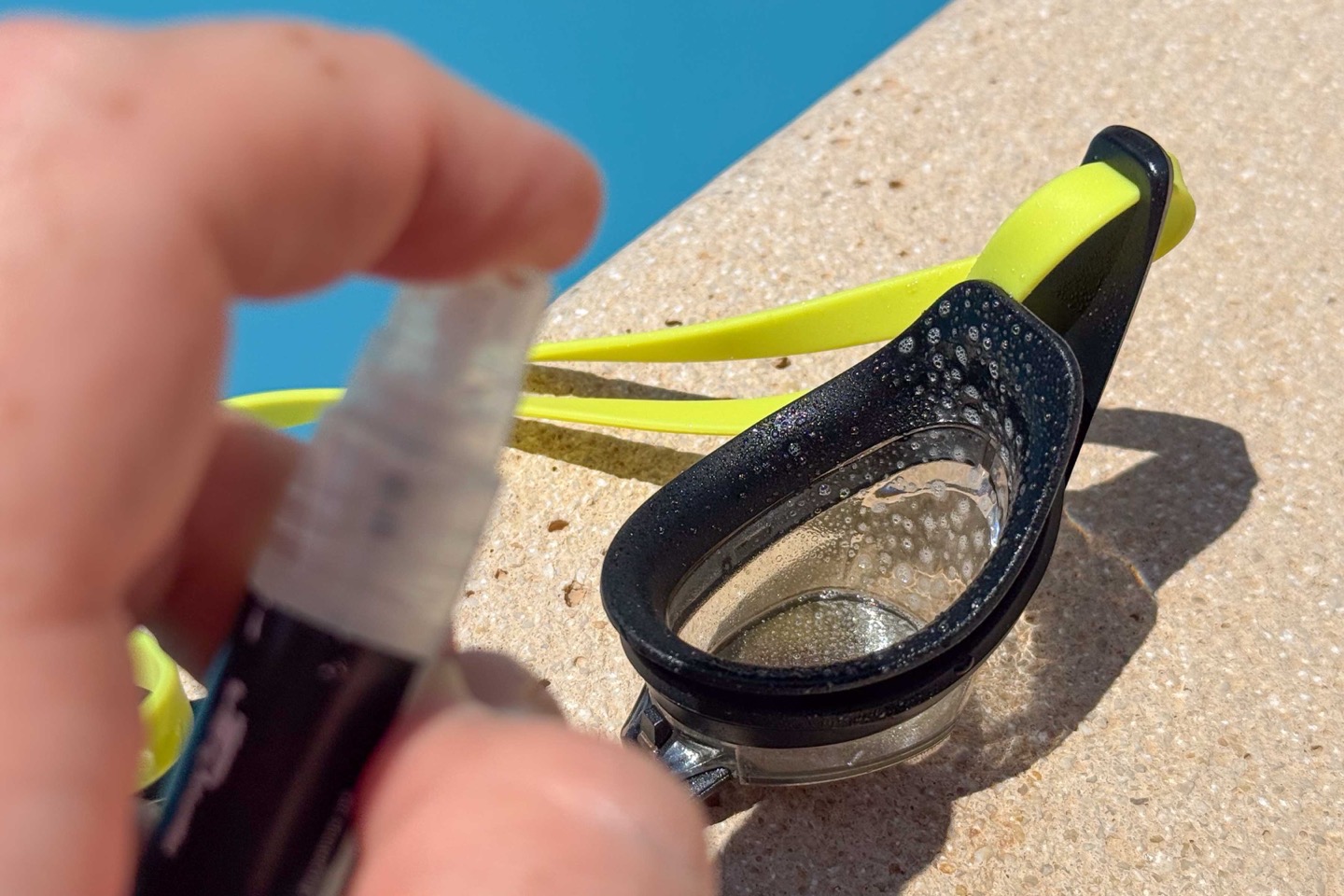
And in my testing, I had zero fogging issues (and I feel like I’m sorta the king of constant fogging issues). Of course, I will point out in fairness that the water temps are stupid warm right now here (both sea and pool), and the biggest factor in fogging is the difference between the water temp and the inside goggle temp (including heat from your body). Right now, those two aren’t all that different. That said, I’ve worn plenty of other goggles in recent weeks, and they fogged on me.
Daily Usage:
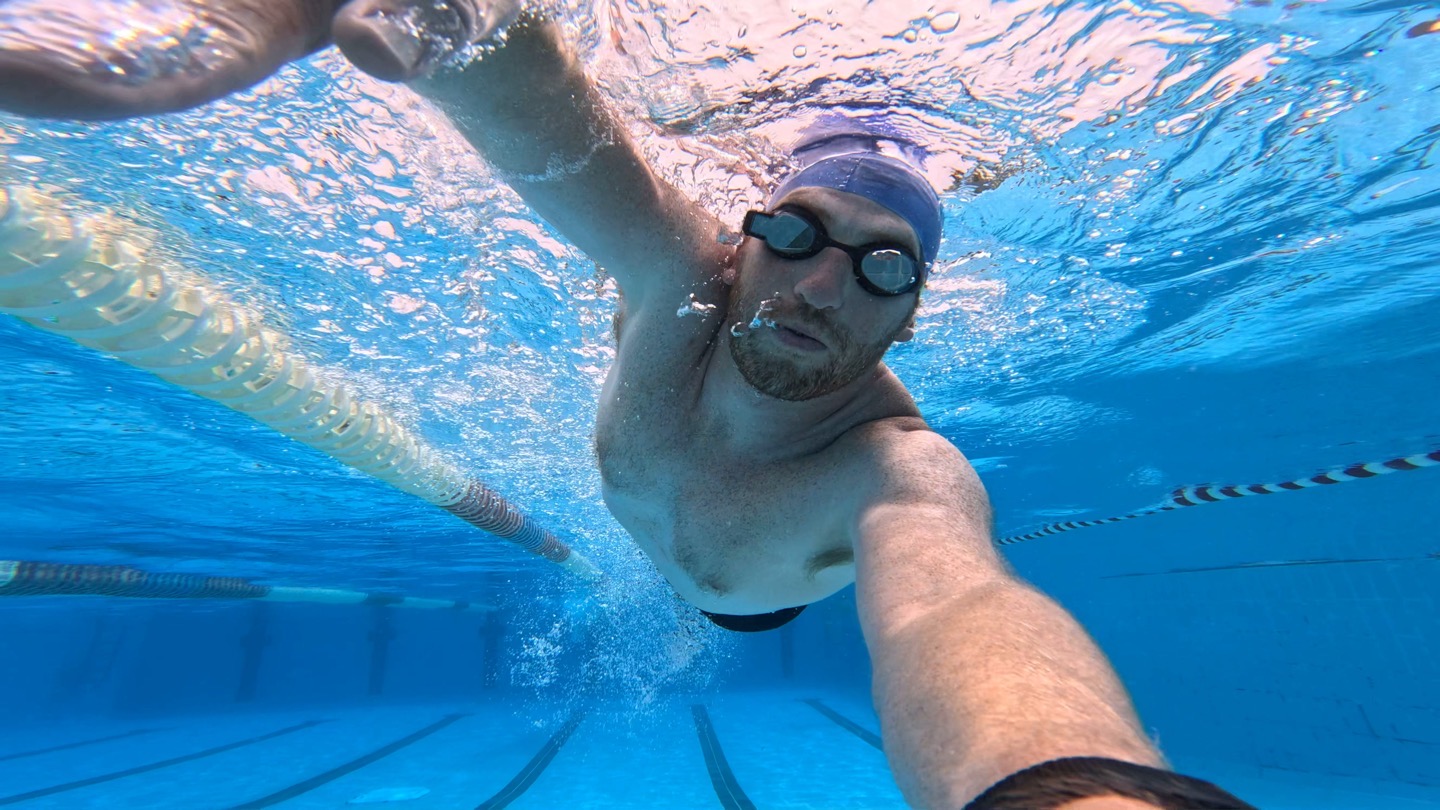
Now, when the FORM Smart Swim 2 came out, I wrote a review about it then. And while it’s gained software features over the past year (as outlined earlier), the core of things has largely stayed the same. They’ve mostly been adding features related to the creation and automation of new structured workouts. But the basics of the unit has remained as before. So, I won’t re-hash all of that, as you can read most of it here in my review from last spring.
However, I will briefly call out some of the new bits, both hardware and software. As well as a super-quick primer. The goggles have a display in one side of them, you can flip which side that is, if you want to. By default, it’s the right side. While that might seem weird to only be in one eye, it works perfectly fine and from a vision standpoint your brain just combines it all together into one cohesive picture:
The text is projected onto a display which just hovers in front of you, making it easy to see. I’ve had no issues with the visibility of the display, even in super bright sunlight. Here’s what it looks like in this image, from FORM – which is pretty close to accurate:
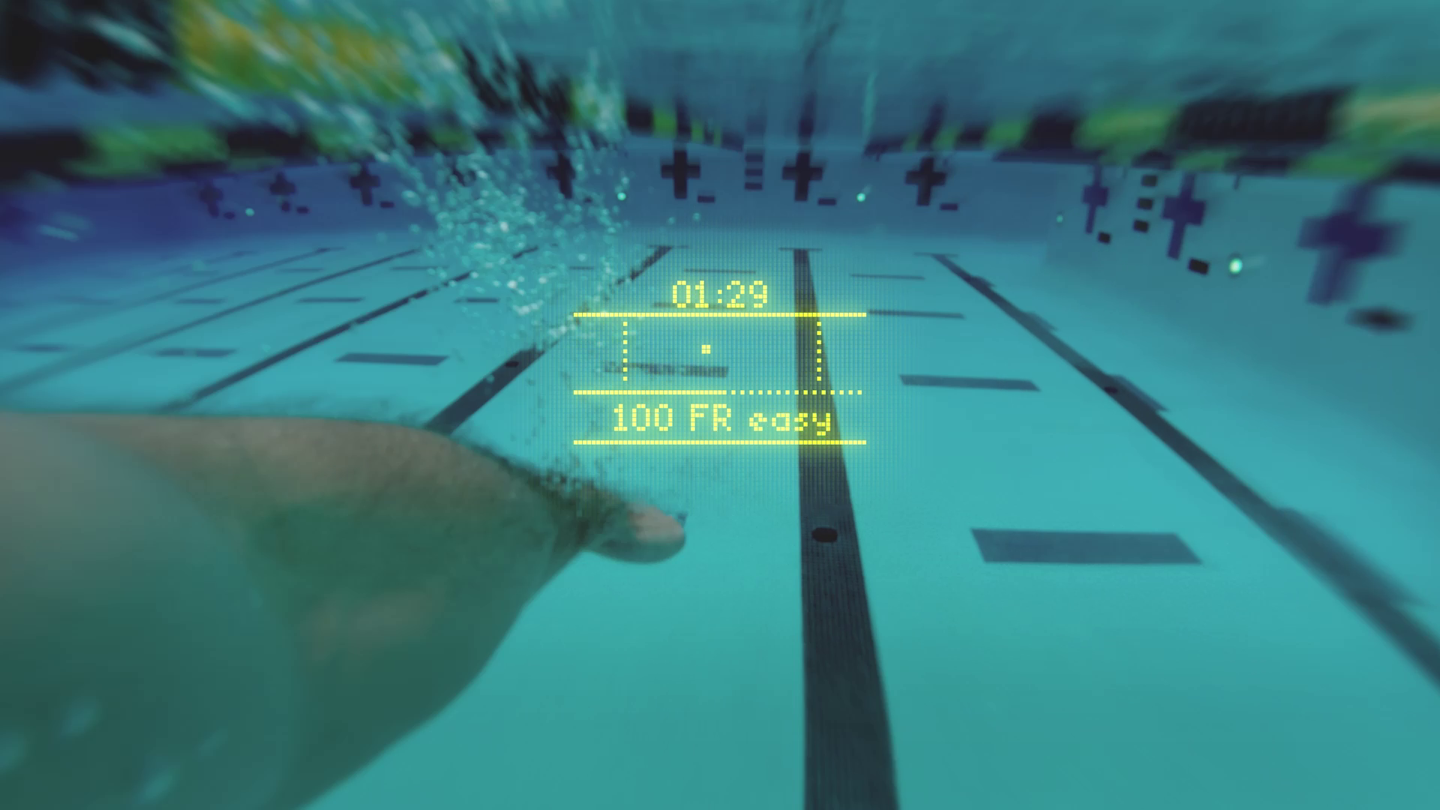
(Taking pictures inside the swim goggle is darn-near impossible due to the way your eye makes it work and getting a camera to focus that close, but the above image is pretty much how it looks in real life).
When you turn on the goggles, it gives you four core options:
– Pool
– Openwater
– Swim Spa
– Settings
All of these are relatively self-explanatory. With an openwater swim though, you can pair it up to either a Garmin or Apple Watch, to get distance (from that watch’s GPS), as well as merging of the data files afterwards. More on that in a second.
Assuming you choose Pool swim, it’ll ask you for the pool length, and then you can choose one of the automatically generated workouts (a workout of the day), one of your existing structured/saved workouts, something from your plan, or simply a ‘Free Swim’.
If you do a structured workout, it’ll iterate you through each section of that workout, one by one. It works super well, and is arguably the shining light of the FORM Swim goggle experience. Of course, all of the structured pieces require a subscription.
Meanwhile, if you do a Free Swim, it’ll simply track your swim stats in real-time. It’ll show you splits as you turn (either flip turn or open turns are fine), as well as total set times. However, new with the July 2025 update is that it’ll now automatically count sets for you, on the fly.
For example, yesterday I started by doing a 500m warm-up, and then eventually transitioned into a pile of 25’s. I wasn’t following a structured workout, I was just…well…keeping myself busy. Later, it’d do a slate of 100’s, and then some 50’s. And throughout it, it’d count each of these in real-time, like below (e.g. the 3×50 FR):

Previously, it’d have just have marked off each interval individually when you paused at the end of the set/interval (e.g. end of 200m or end of 500m or end of 50m), now, it counts these up, if you’re doing repeating intervals.
My only minor complaint here is that if I was trying to do 100’s on a given number (e.g. 100’s on 1:40), then the way the timer appears/disappears makes this kinda hard. I’m back to just doing mental math with figuring out how much rest time I have based on remembering the last split time. Overall this is great for distance tracking, and perhaps there’s a different way I can configure my data pages, though I don’t see any automation around that.
As has always been the case, FORM’s ability to correctly count all of my lengths correctly is their main jam. I can’t remember the last time it missed a length or otherwise screwed up. Whereas watches, while very good, can be a bit easier to trick when others do weird things in your lane line that cause you to have to pause or such.
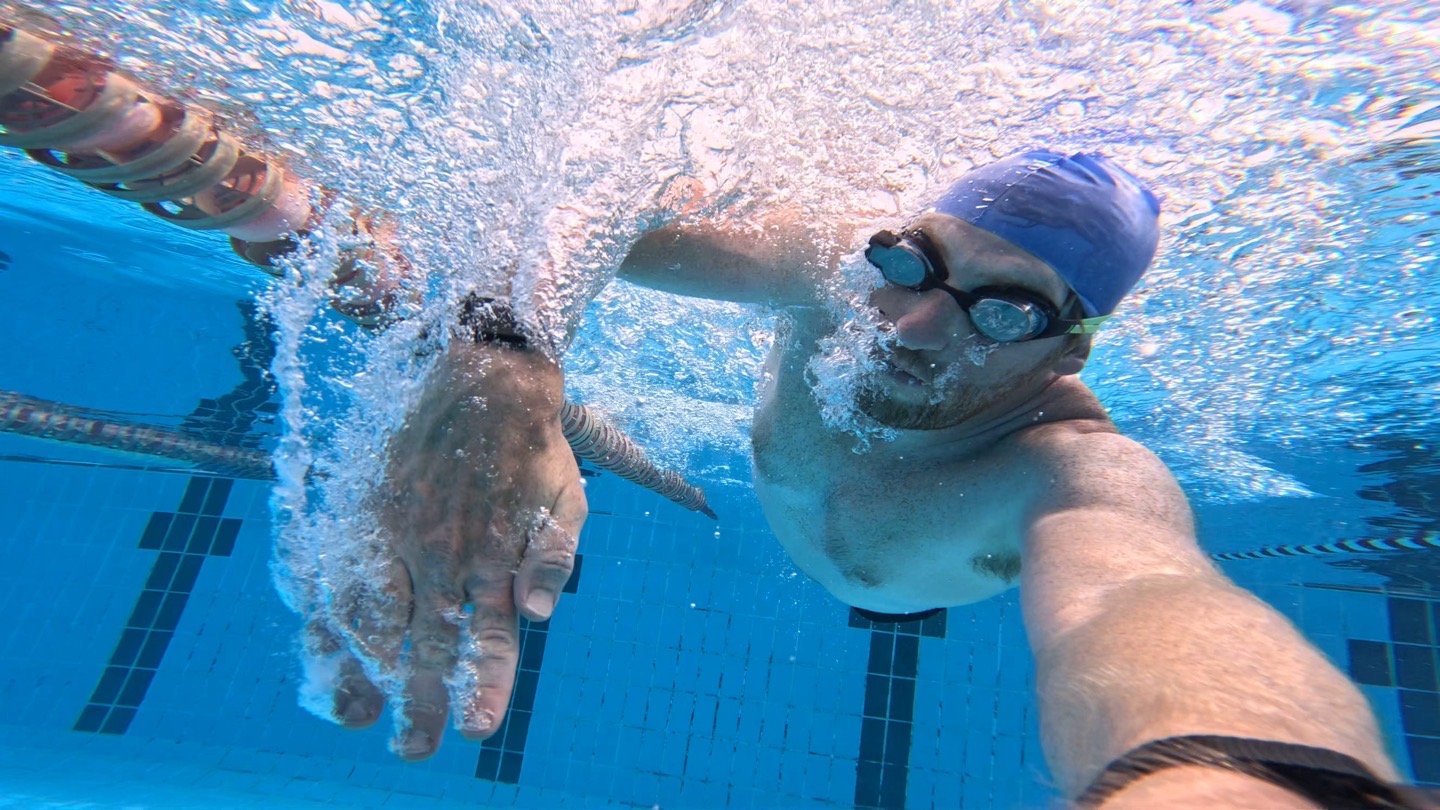
In any event, once you’re done with your workout, you’ll see summary stats on the goggles, and then later in the app as well (heart rate is that red line):
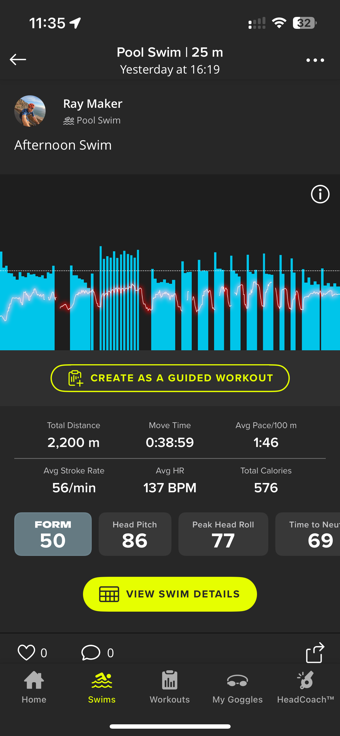
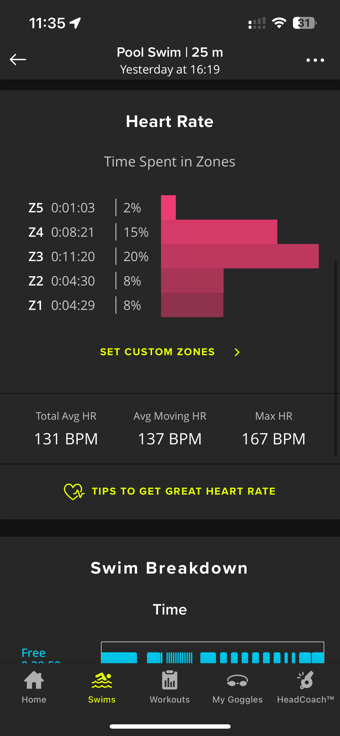
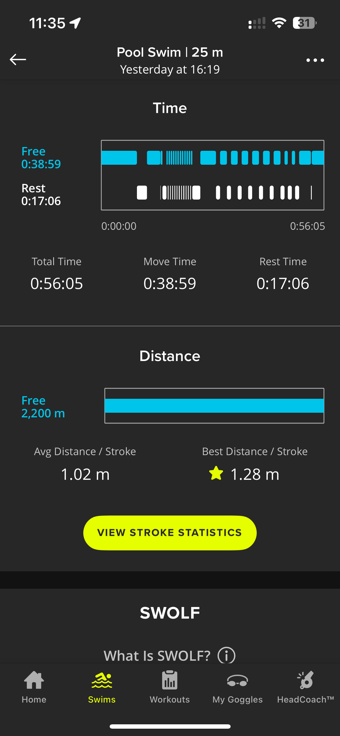
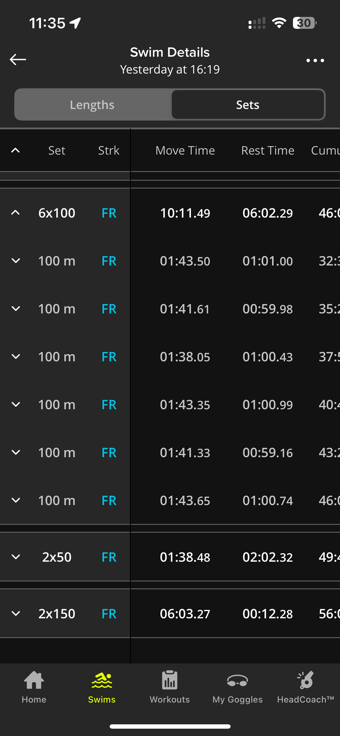
This also includes the various technique scores within the HeadCoach realm, as well as other scores like interval pacing:
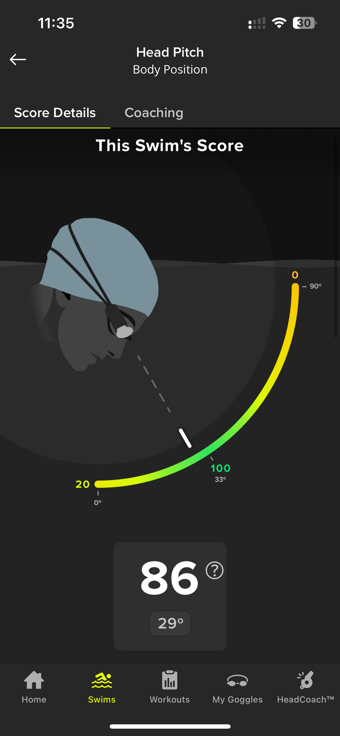
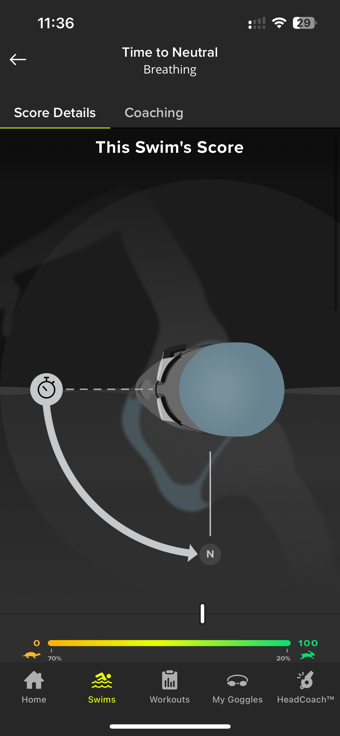
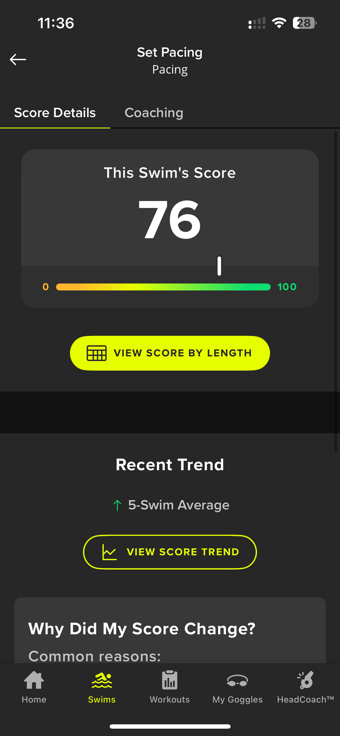
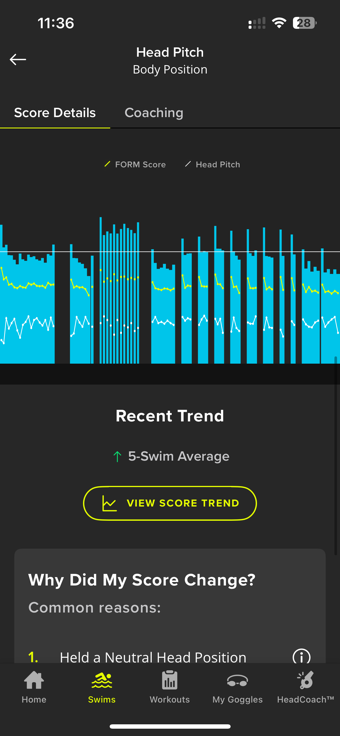
It’s within that app that you can configure all your settings, including all your data page views (called Dashboards), as well as other settings (dashboard views are unique per pool/openwater/swimspa):
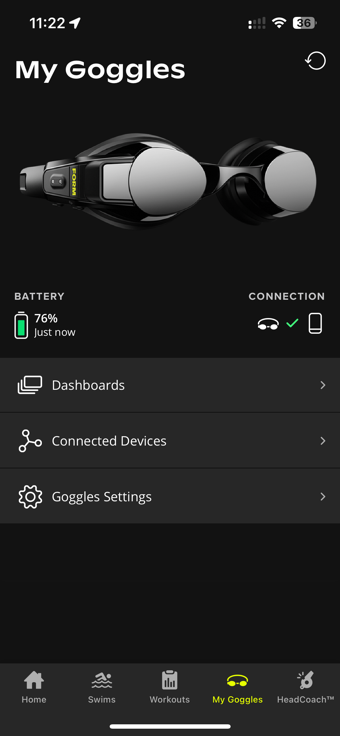
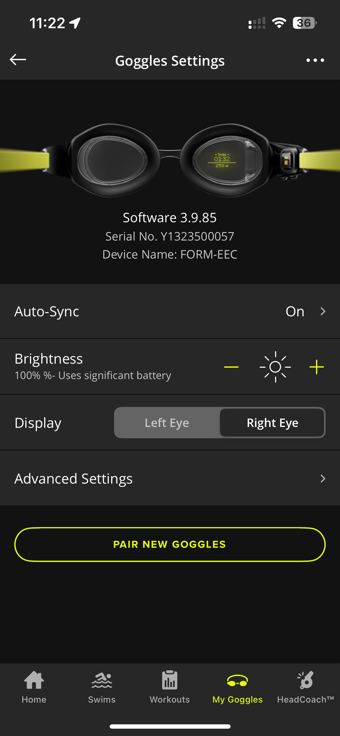

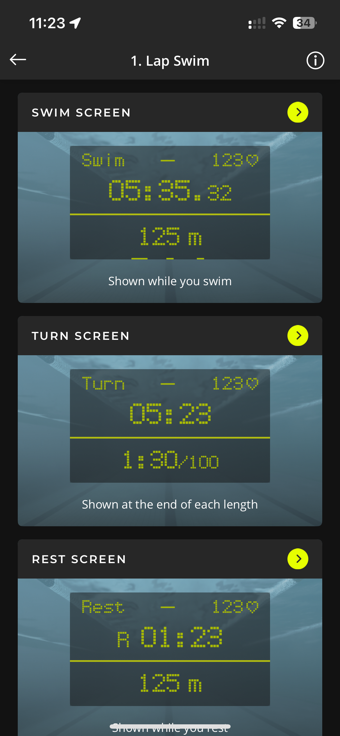
Likewise, it’s where you can create, check, and otherwise look at structured workouts and plans.
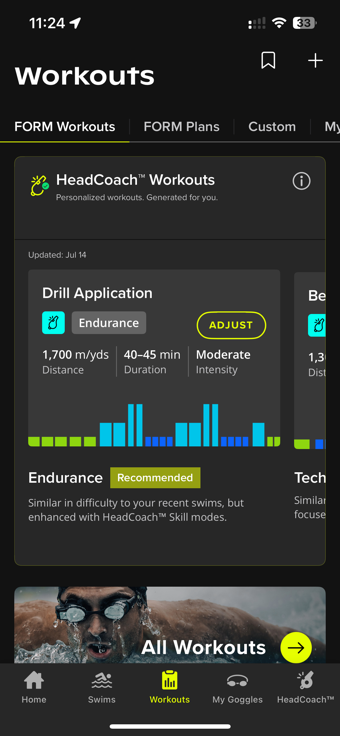

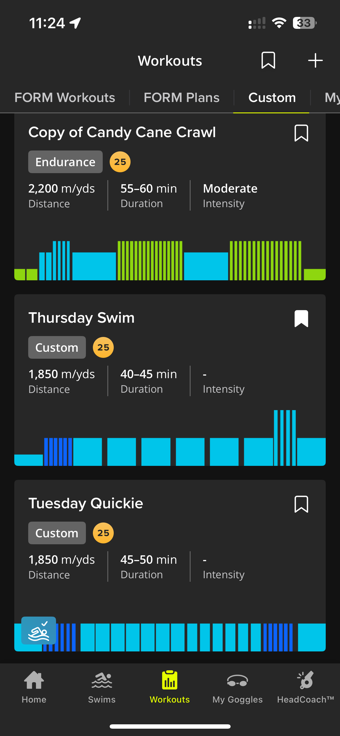
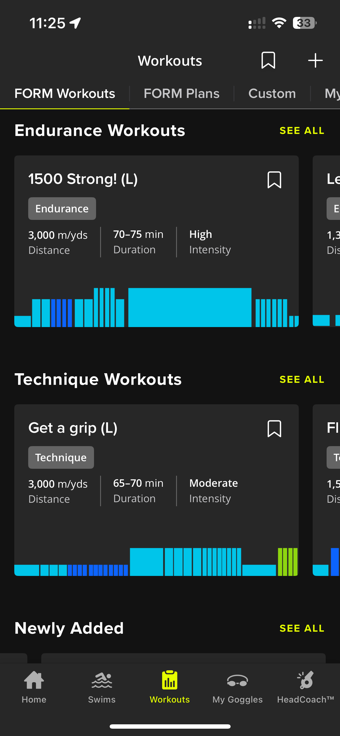
Finally, when it comes to openwater swims, you can pair up the goggles to most Garmin watches and Apple Watches. While the FORM Swim Goggles can act on their own for openwater swimming, they can’t calculate distance (or a GPS track) without some sort of watch, as there isn’t GPS inside the goggles. So if you don’t have a watch paired, you’ll still see heart rate, compass/SwimStraight, and time. In fact, on the swim below, my wife used hers in that configuration, whereas I used the watch combo option.
In my case, I paired it up to a Garmin Forerunner 970, using their Connect IQ app. They walk you through the steps, and it’s pretty straightforward to get it going. Once that’s done, you’ll simply select the Openwater option, and off you go:
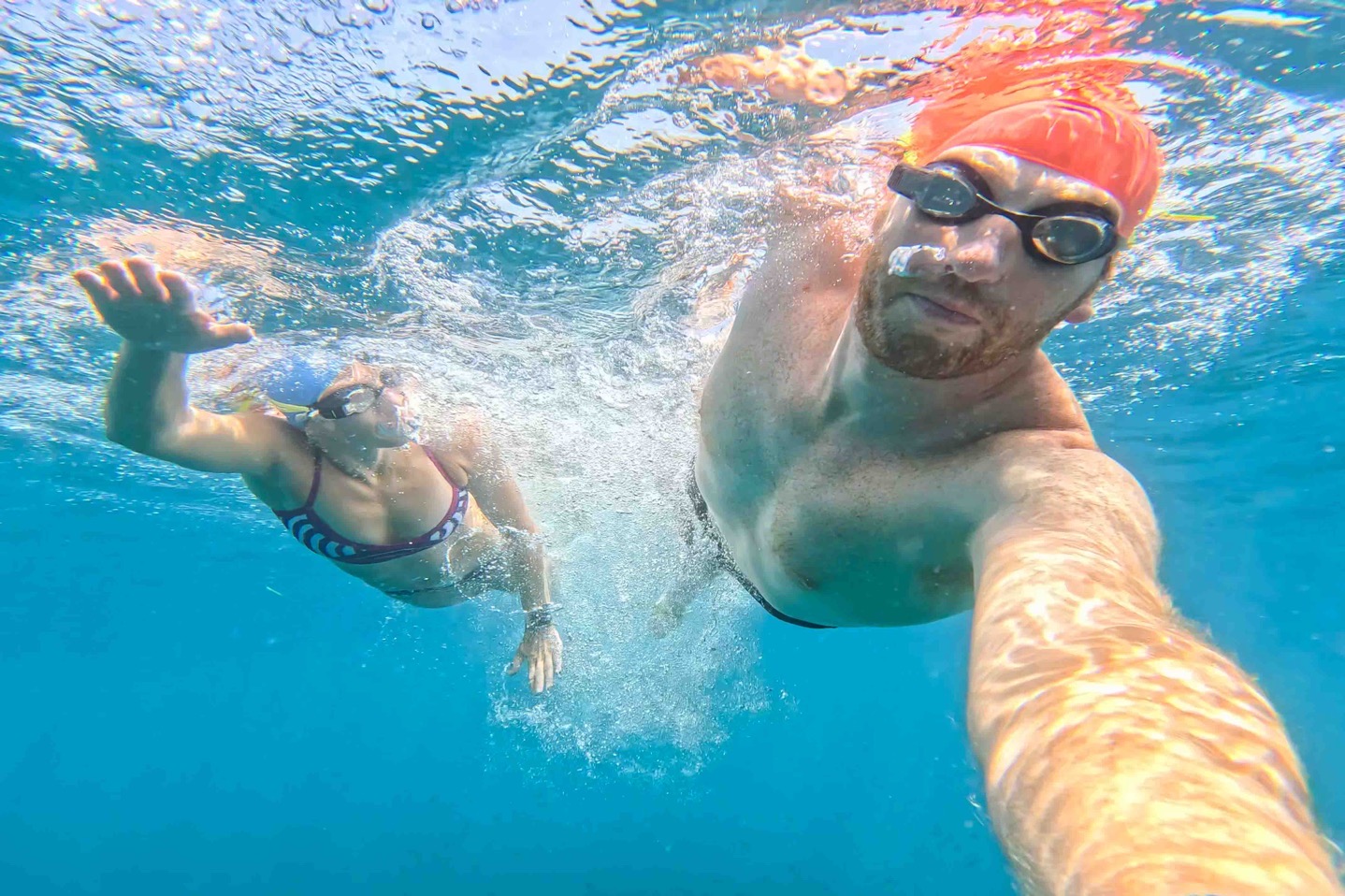
In the original Smart Swim 2 release, they added what is essentially a compass, to help you swim straight. That’s all it is, just a compass. The idea being you can hold a given heading, to assist with openwater swims (especially with saves and such). This is useful if openwater swim sighting isn’t really your strongest suit.
As noted, I don’t have a good way to take photos inside the goggles while openwater swimming, but FORM did a superimposed view of the compass, which looks like this:
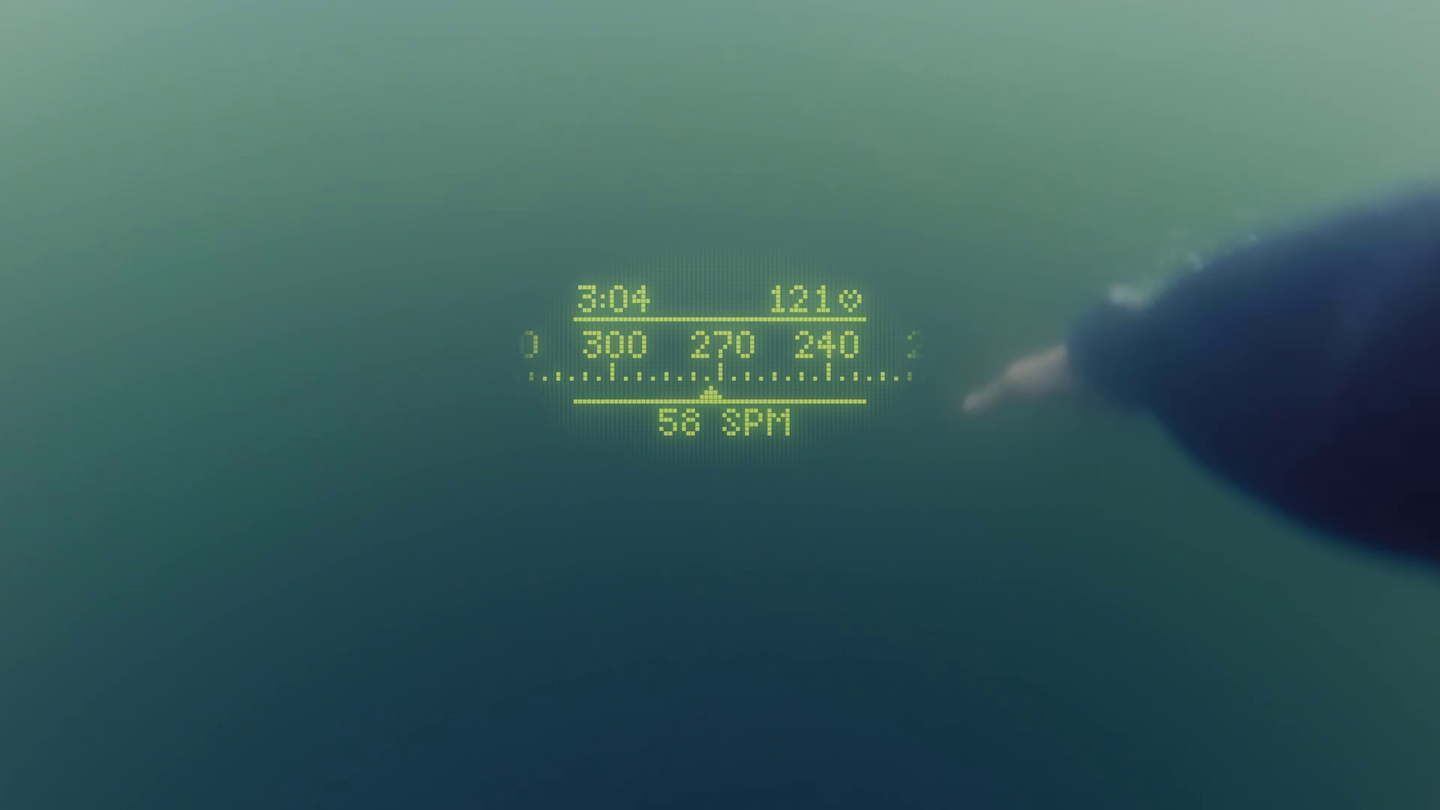
If you don’t sight for a while, it’ll actually tell/force/remind you to sight. Likewise, if it’s having connectivity problems to the watch, it’ll remind you to lift your arm a little bit higher on the recovery (the part in the air), since that’s when the connection is made and the data is constantly transferred.
As I said last year, I do find this feature useful, but at the same time, I’m probably not the best judge of it. Most people would argue I swim stupidly straight in openwater, even rough waters, without much need for straightness assistance. But I can see how it would be quite useful if keeping things pointed in a single direction were a challenge.
Once your openwater swim is done, you’ll see the full merged stats within the FORM Swim app (as well as your Garmin or Apple summary stats pages/apps):
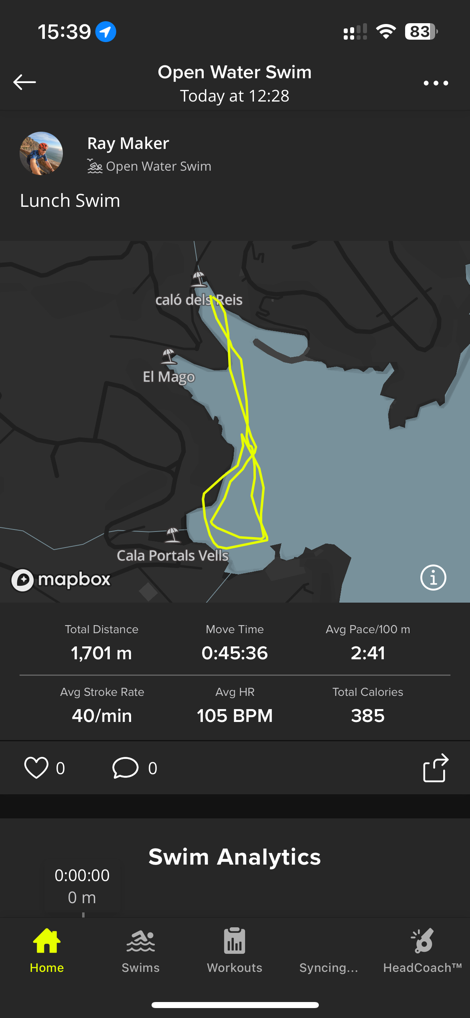
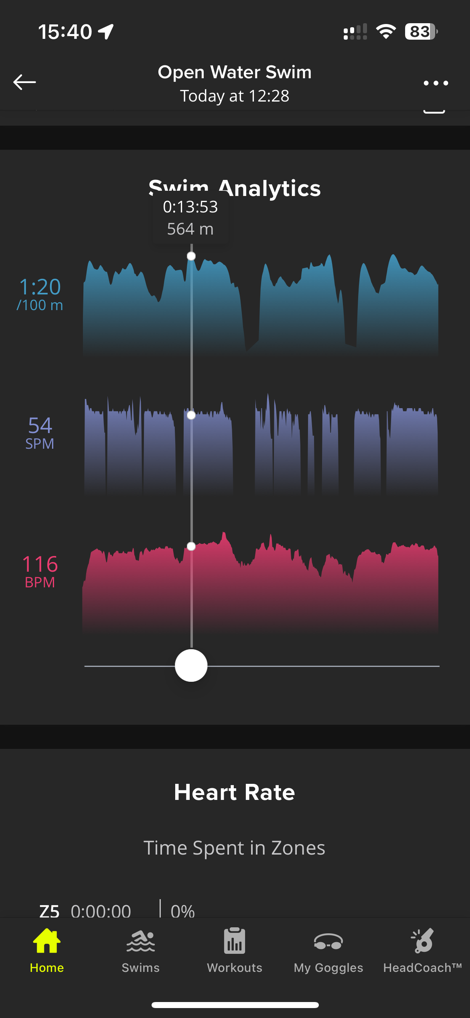
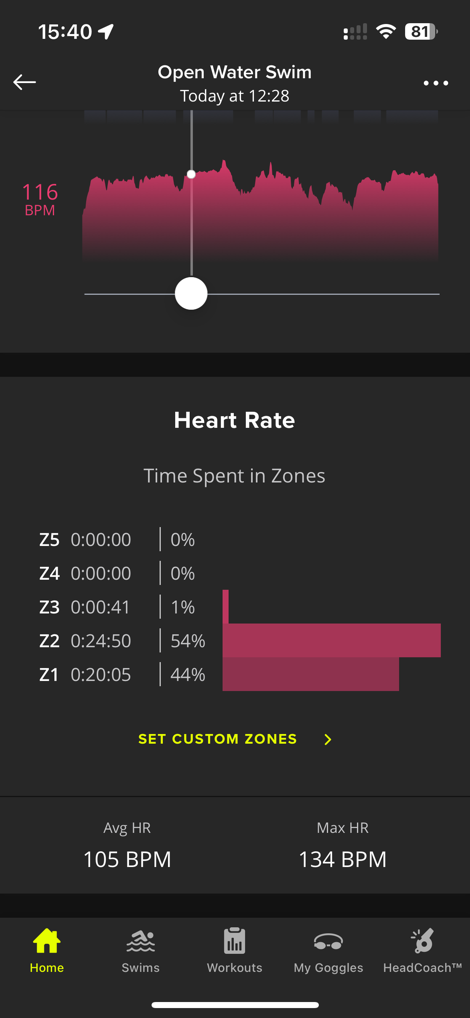
Finally, as for the visibility of the goggles (in either openwater or pool), that remains the same. Meaning, my primary complaint has always been the limited side visibility of the FORM swim goggles compared to traditional goggles (and even more-so compared to the much greater visibility of most openwater/triathlon swim goggles today). That unfortunately, is the same as the past. It’s fine/OK in the pool, but is a far cry from great in openwater.
FORM did note that they are keenly aware of this desire, but that making significant changes wasn’t in the cards for this hardware iteration. Additionally, finding a way to bridge that larger field of view gap with a display in the goggles is challenging. Still, I’m hopeful they’ll find a way to do so. It’s honestly the singular reason I don’t swim with the FORM goggles as a daily driver in openwater, purely because I want more visibility. In the pool, it doesn’t bother me as much.
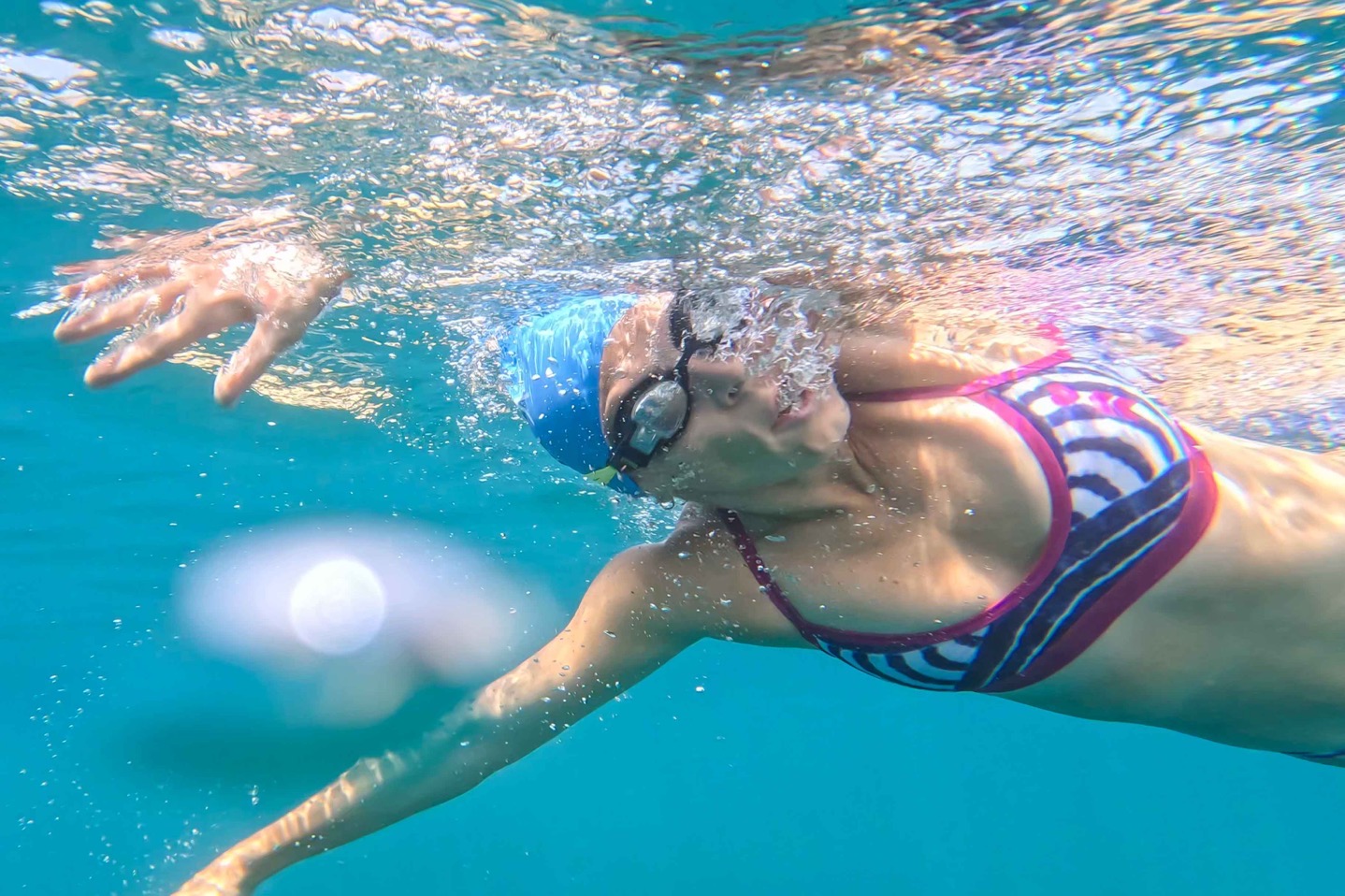
Likewise, my wife has used the FORM Swim goggles in the past a ton for pool swims, and really likes them there (including pulling in her TrainingPeaks workouts). But somehow this was her first swim in openwater with them. She had many choice words about viability this morning, none of which were positive. But, she also says she loves them in the pool.
Wrap-Up:
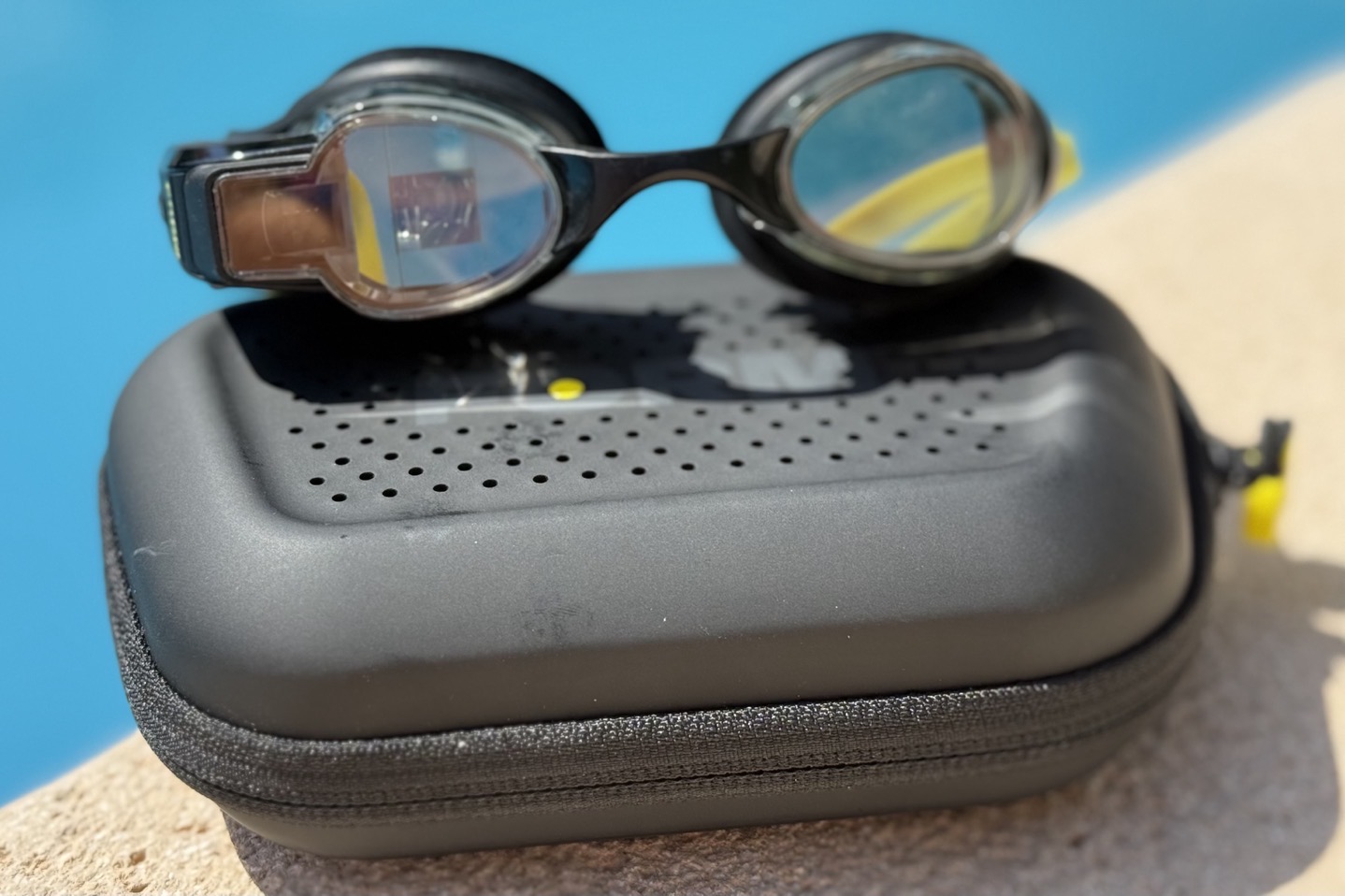
As has been the case since the first FORM Swim Goggle, the company has largely made incremental hardware changes each time, with the most notable one last time being the addition of heart rate (using a sensor on the side). This time around it was focused on one of the biggest complaints/concerns people had, which was durability of a $300 swim goggle. After all, you can get ~10 good/normal swim goggles for that, so it’s gotta last.
In this case, my initial testing is certainly showing strong promise there. How that manifests itself over the course of a year or two…I don’t know. But I do know the pool edge is very gritty, and happily takes off skin – yet didn’t leave any visible marks here at all.
In terms of software, FORM continues to do a very solid job at increasing that portfolio, though, mostly/entirely if you’ve got a subscription. If you don’t, then very few, if any, of the new features/improvements over the past while will be applicable to you. That of course, won’t appeal to everyone. But it does seem to appeal to FORM’s core audience, and FORM showed a ton of behind the scenes data looking at their user base indicating the training plans are making their core audience faster, and doing so at a rate faster than Free Swim users.
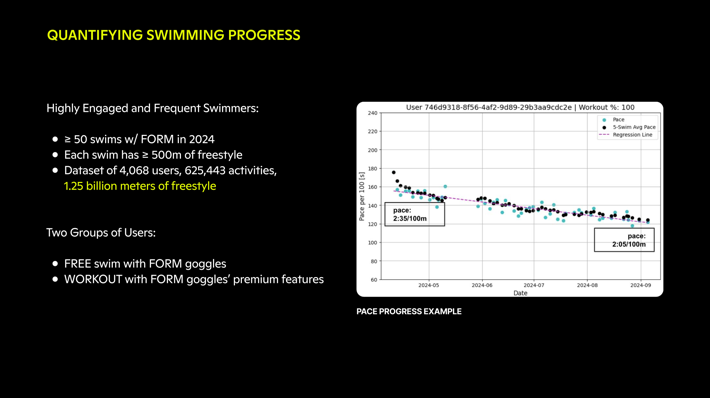
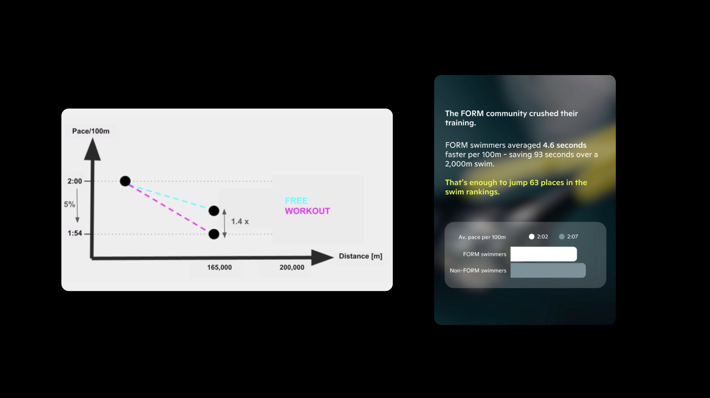
As I said above, I enjoy the tech side of the goggles during a pool swim, especially how well it integrate with TrainingPeaks, as well as just the structured workouts that are included. I just wish/hope their next hardware iteration finds a way to address the side visibility piece, which since the first iteration is what I’d consider the hinderance to usage in openwater swimming. Still, most people aren’t triathletes, and thus, probably isn’t a blocker. Or, their usage outside is far less than their pool usage.
In which case, I don’t have any issues recommending the FORM Swim Goggle, so long as it fits your budget.
With that, thanks for reading!


0 Commentaires